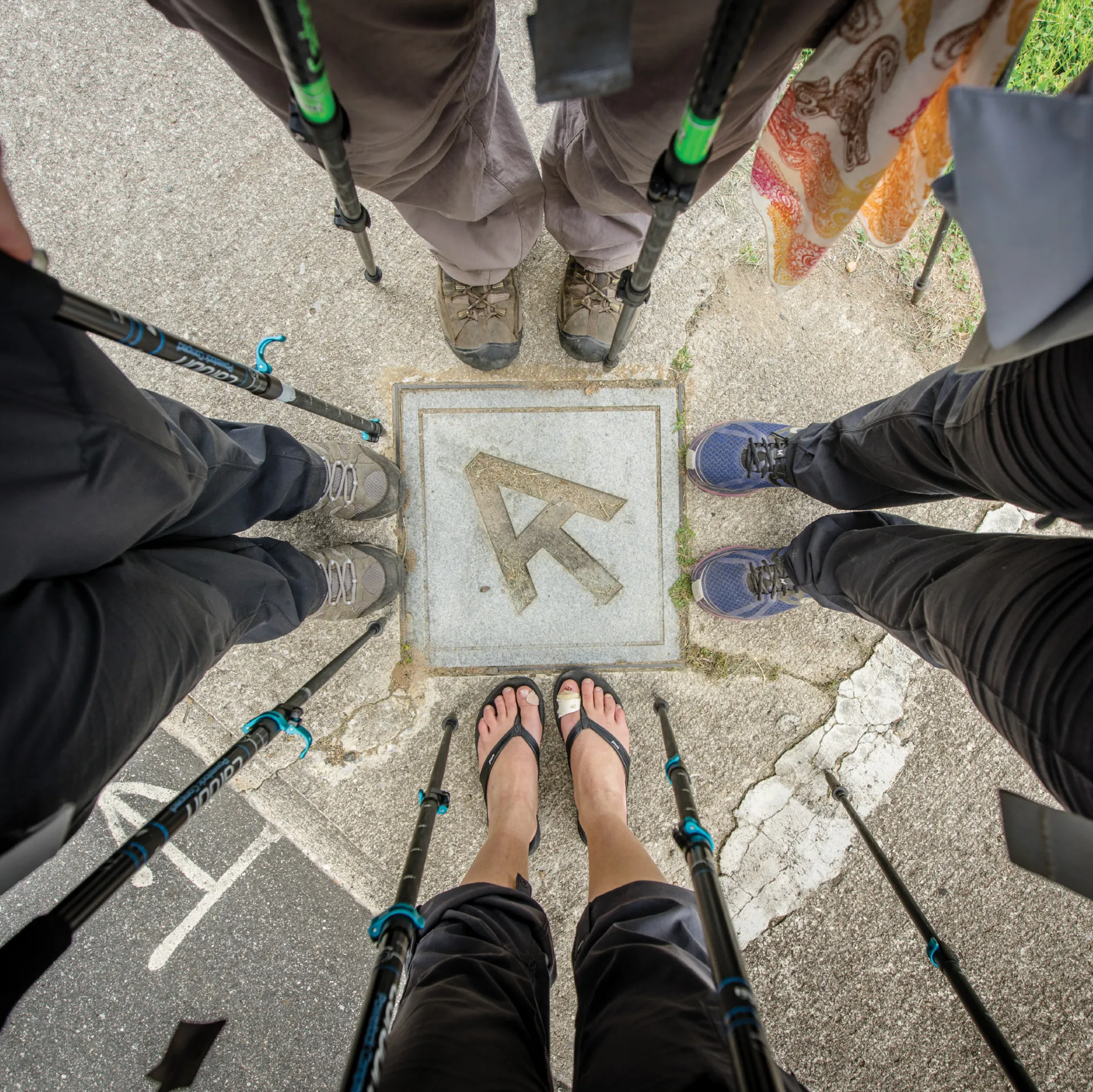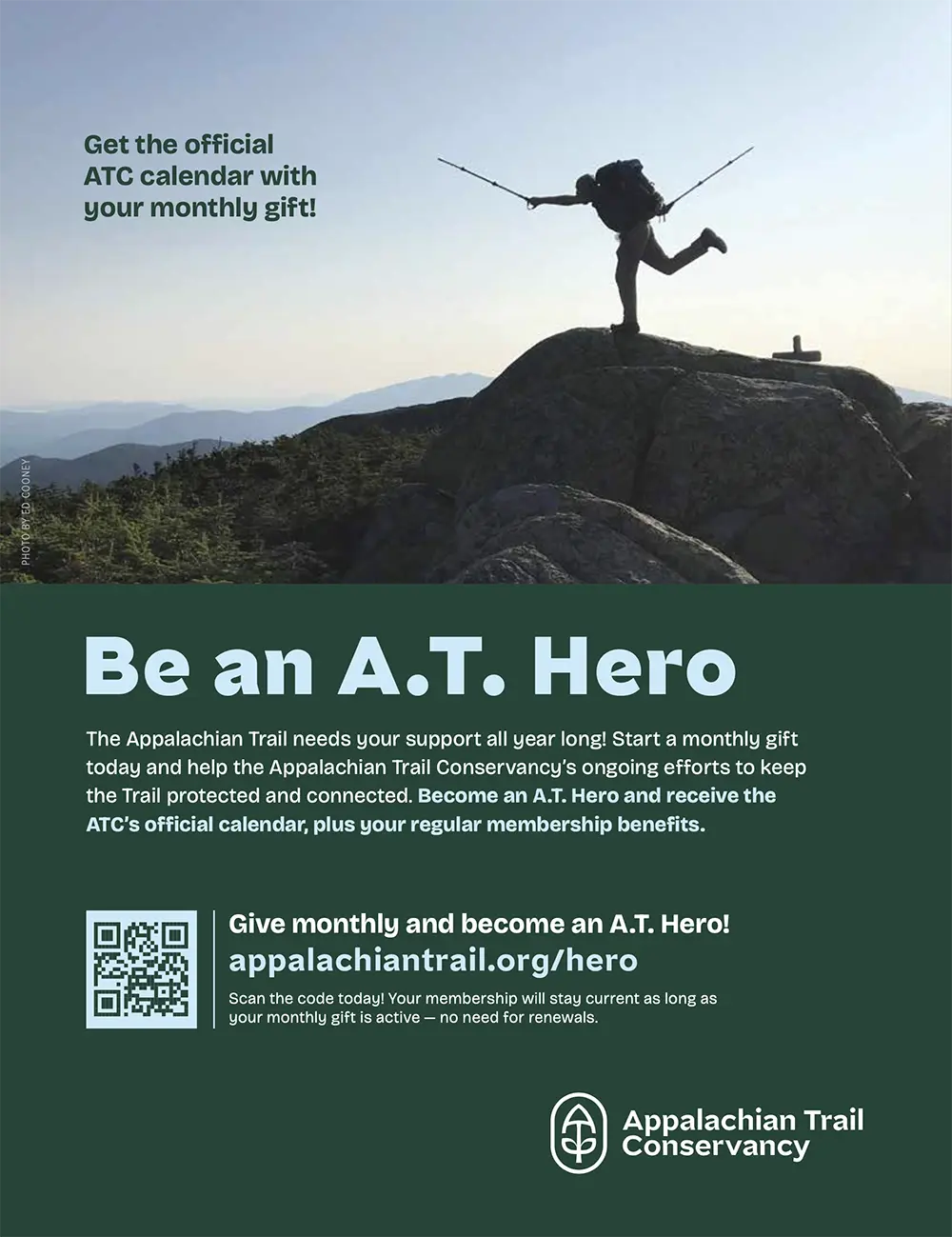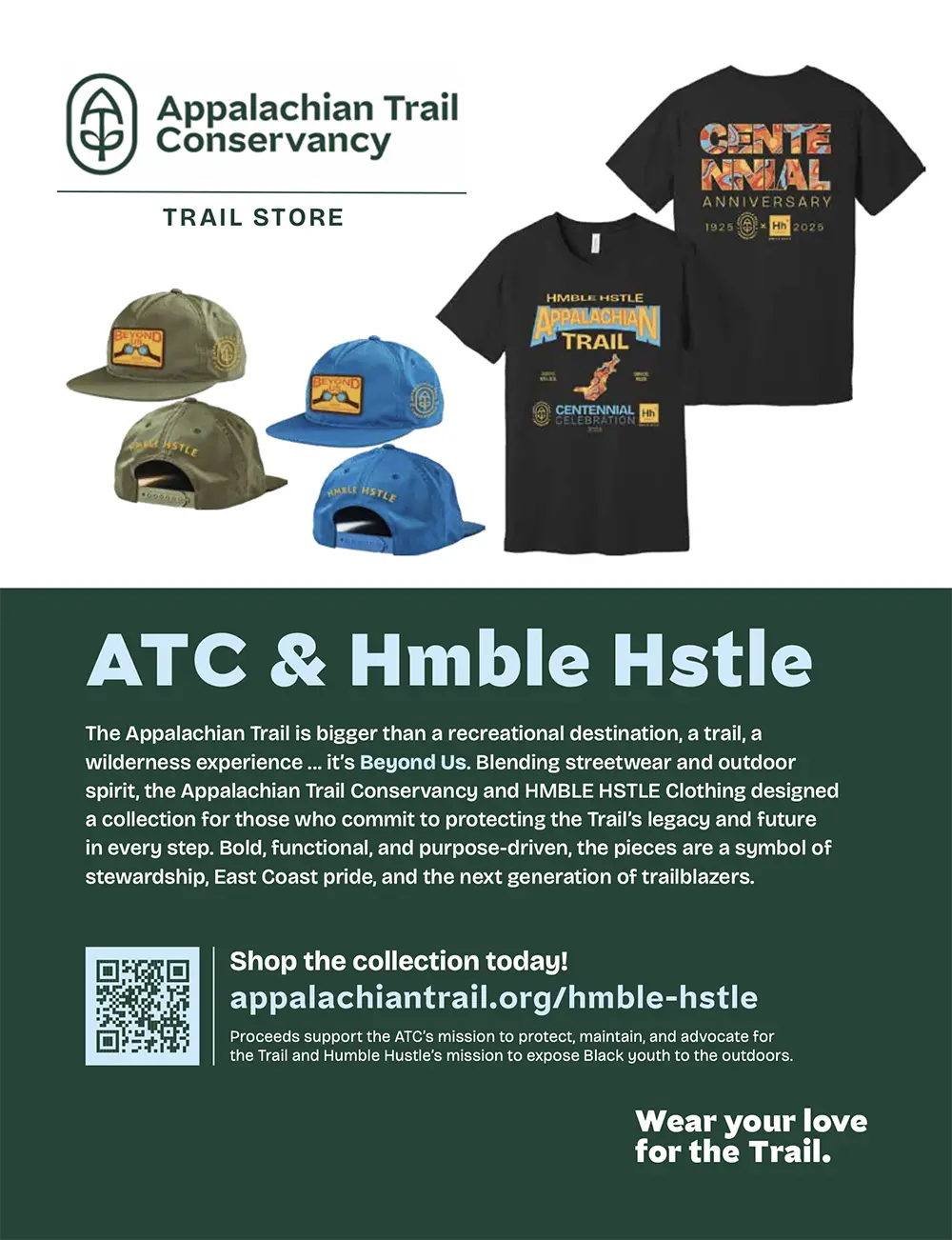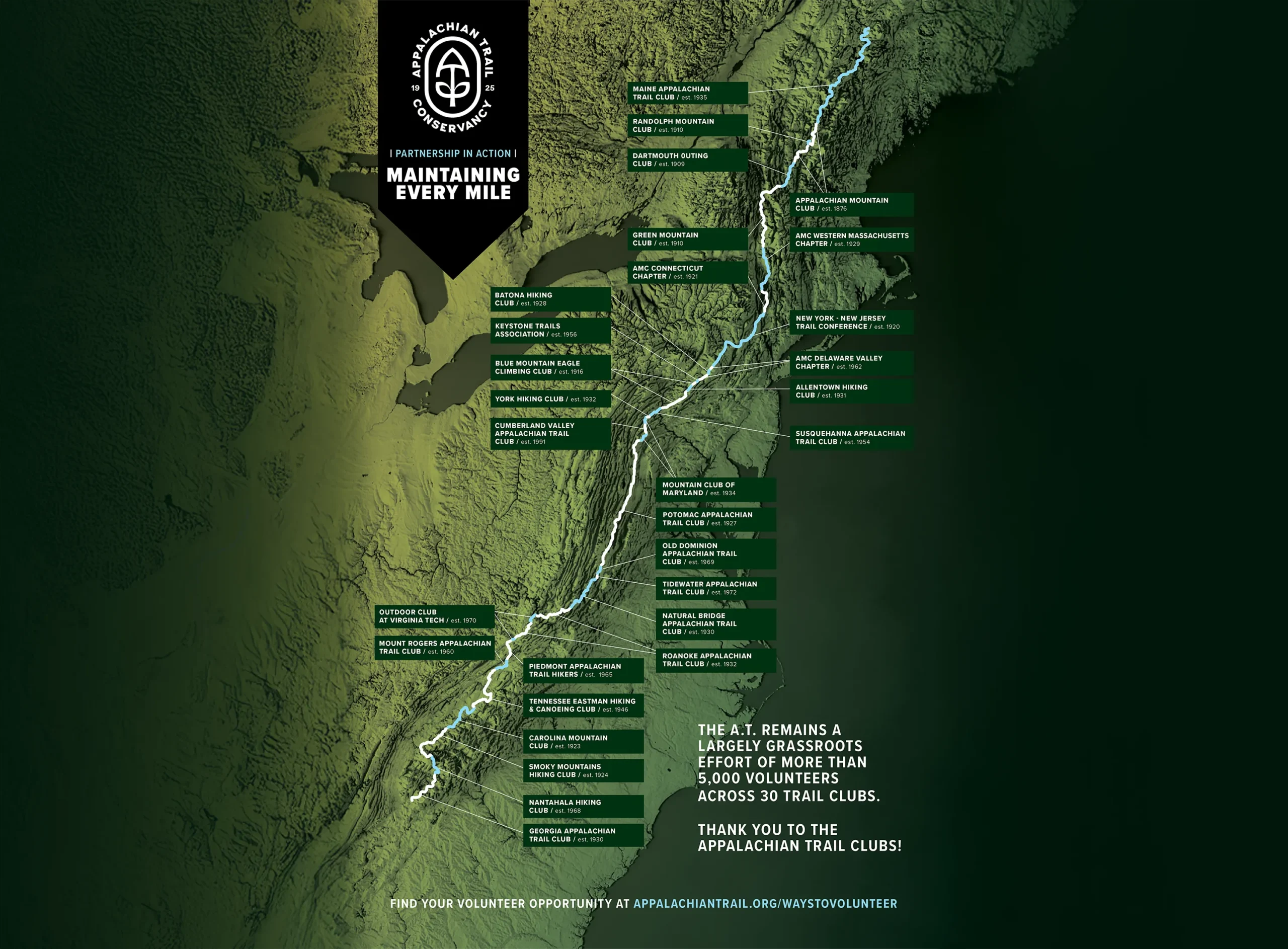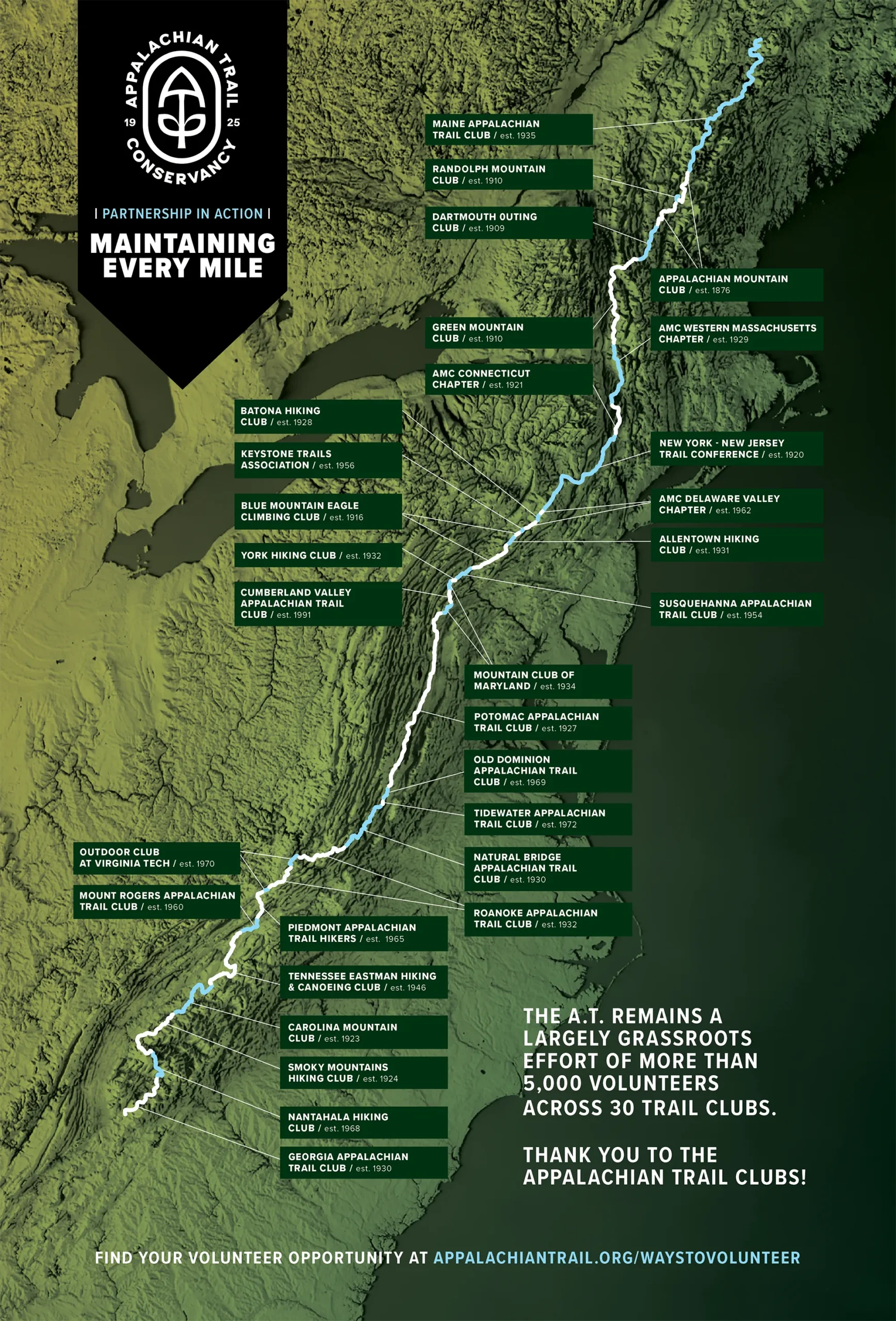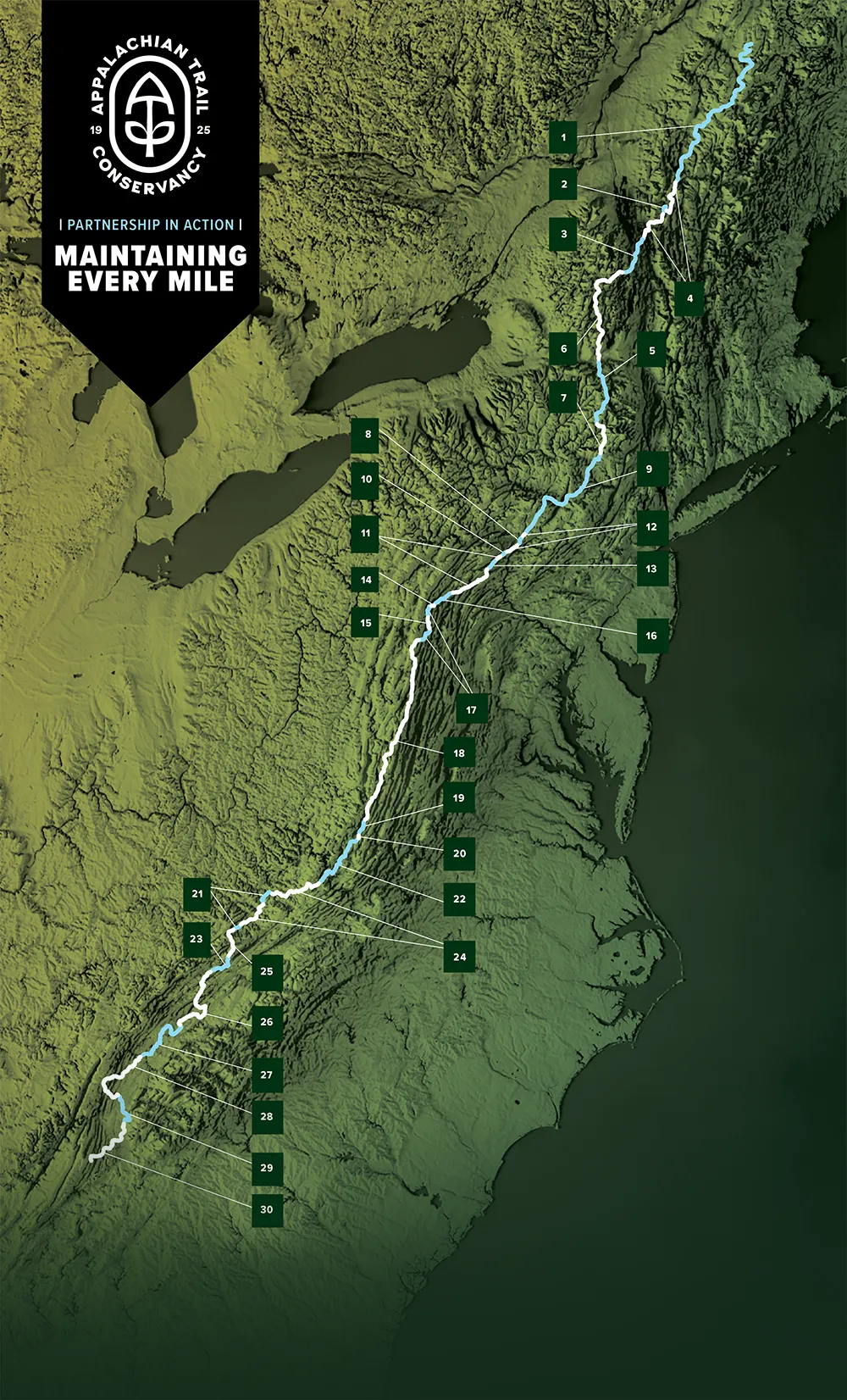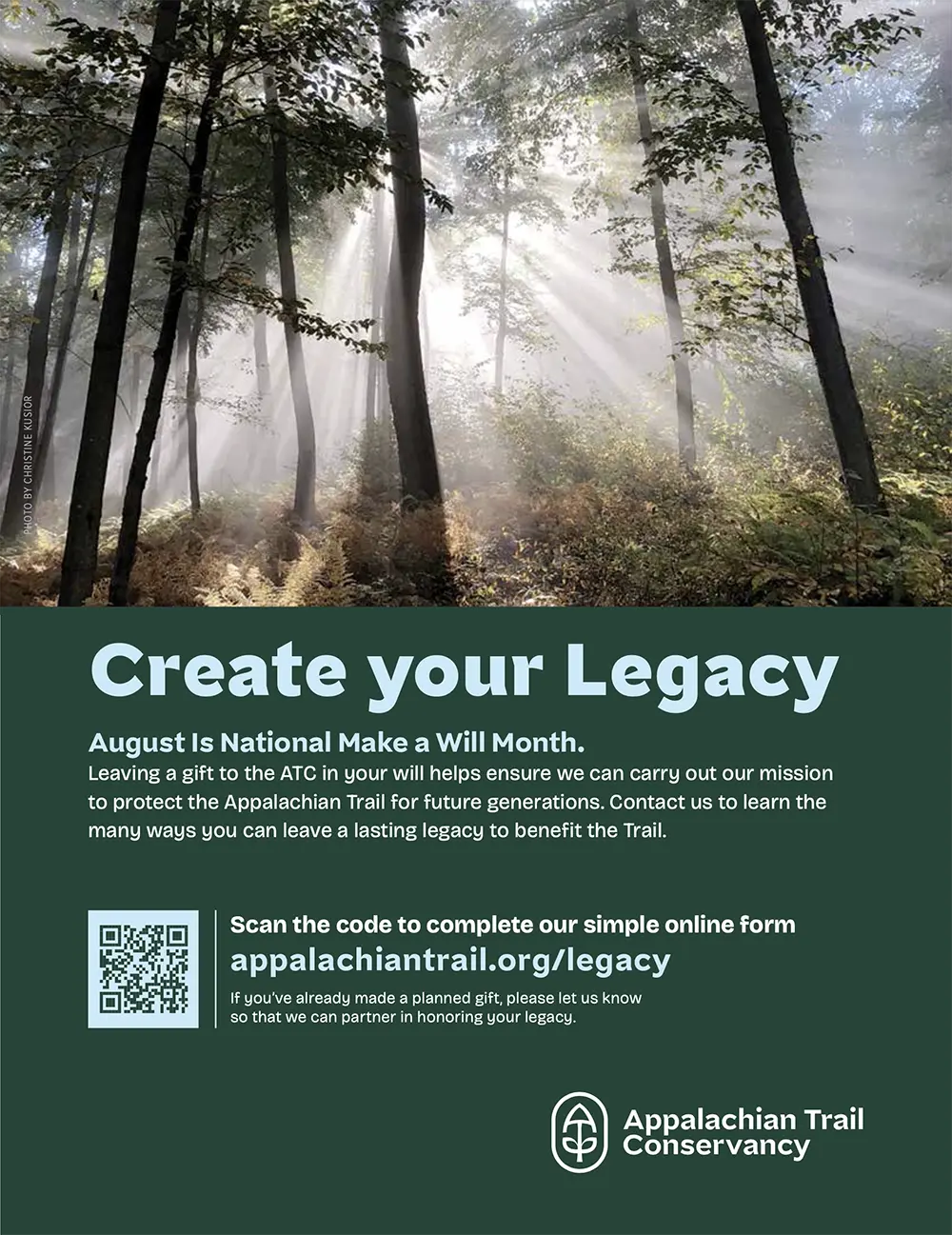Synergy on the Trail: A white-lined sphinx month (Hyles lineata) pollinates scarlet beebalm (Monarda didyma). Using their long proboscis, the moths can access nectar inside the long, tubular flowers. These striking creatures have a wide native range and can be spotted along the Trail in all 14 states, often when they emerge at dusk to seek out sweet-scented flowers. Photo by Greg Vandeleest / iStock
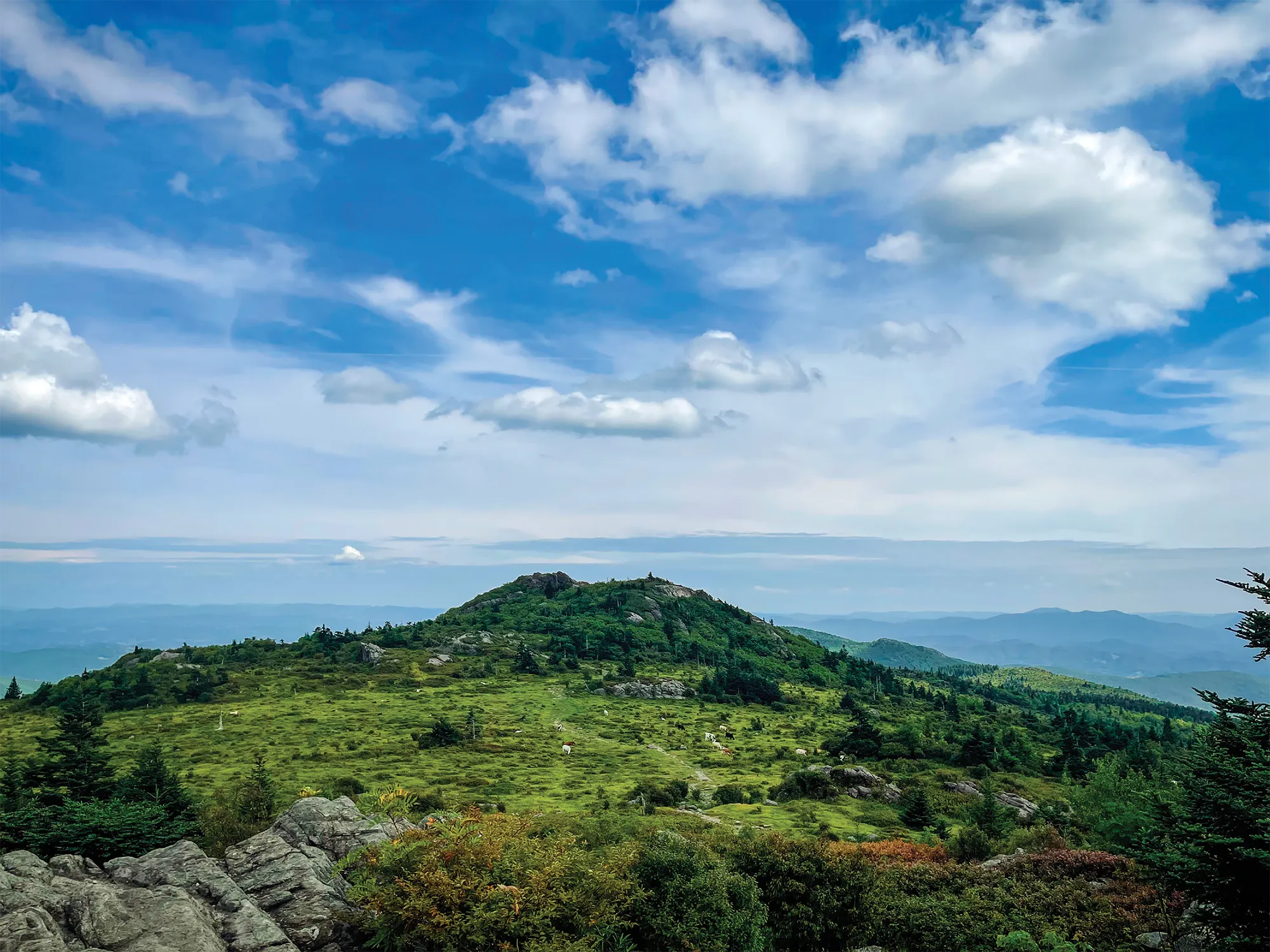
Synergy on the Trail: A white-lined sphinx month (Hyles lineata) pollinates scarlet beebalm (Monarda didyma). Using their long proboscis, the moths can access nectar inside the long, tubular flowers. These striking creatures have a wide native range and can be spotted along the Trail in all 14 states, often when they emerge at dusk to seek out sweet-scented flowers. Photo by Greg Vandeleest / iStock

MISSION
Our mission is to protect, manage, and advocate
for the Appalachian National Scenic Trail.
VISION
The Appalachian Trail and its landscape are
always protected, resilient, and connected for all.
ATC Executive Leadership
Sandra Marra / President & CEO
Karen Cronin / Chief Financial and Administrative Officer
Hawk Metheny / Vice President of Regional and Trail Operations
Dan Ryan / Vice President of Conservation and Government Relations
Jeri B. Ward / Chief Growth Officer
A.T. Journeys
Caroline Ralston / Associate Vice President of Marketing & Communications
Genevieve Andress / Relationship Marketing and Membership Director
Karen Ang / Managing Editor
Traci Anfuso-Young / Art Director / Designer
A.T. Journeys is published on matte paper manufactured by Sappi North America mills and distributors that follow responsible forestry practices. It is printed with Soy Seal certified ink in the U.S.A. by Sheridan NH in Hanover, New Hampshire.
A.T. Journeys ( ISSN 1556-2751) is published by the Appalachian Trail Conservancy, 799 Washington Street, Harpers Ferry, WV 25425, (304) 535-6331. Bulk-rate postage paid at Harpers Ferry, West Virginia, and other offices. Postmaster: Send change-of-address Form 3575 to A.T. Journeys, P.O. Box 807, Harpers Ferry, WV 25425.
Board of Directors
- Jim LaTorre / Chair
- Gregory Merritt / Vice Chair
- Yong Lee / Secretary
- Katherine Ross / Treasurer
- Eboni Preston Goddard / Representative to Stewardship Council
- Sandra Marra / President & CEO
- Renee Alston-Maisonet
- Ashley Campbell
- Rich Daileader
- Grant L. Davies
- Bill Holman
- Roger Klein
- John W. Knapp, Jr.
- Lisa Manley
- Nathan G. Rogers
- Patricia D. Shannon
- Rajinder Singh
- Durrell Smith
- Greg Winchester
- Nicole Wooten
A.T. Journeys is published on matte paper manufactured by Sappi North America mills and distributors that follow responsible forestry practices. It is printed with Soy Seal certified ink in the U.S.A. by Sheridan NH in Hanover, New Hampshire.
A.T. Journeys ( ISSN 1556-2751) is published by the Appalachian Trail Conservancy, 799 Washington Street, Harpers Ferry, WV 25425, (304) 535-6331. Bulk-rate postage paid at Harpers Ferry, West Virginia, and other offices. Postmaster: Send change-of-address Form 3575 to A.T. Journeys, P.O. Box 807, Harpers Ferry, WV 25425.
Whether hiking or volunteering on the Trail or leading the organization entrusted with its care, these themes have resurfaced throughout my four decades of A.T. stewardship, and I am confident they are a focus for the ATC’s Board of Directors as they search for my successor.
The Trail’s remarkable partnership model represents one of conservation’s greatest success stories. It is what first drew me to the Trail as an idealistic twenty-something-year-old. This collaboration between citizen volunteers and the federal government, alongside state and local jurisdictions, communities, and conservation organizations, has created a grassroots network that forms the backbone of the Trail’s endurance and resilience. And it is a shining example of how collective energy can truly create and protect what is most important.
trailhead
highlights / events
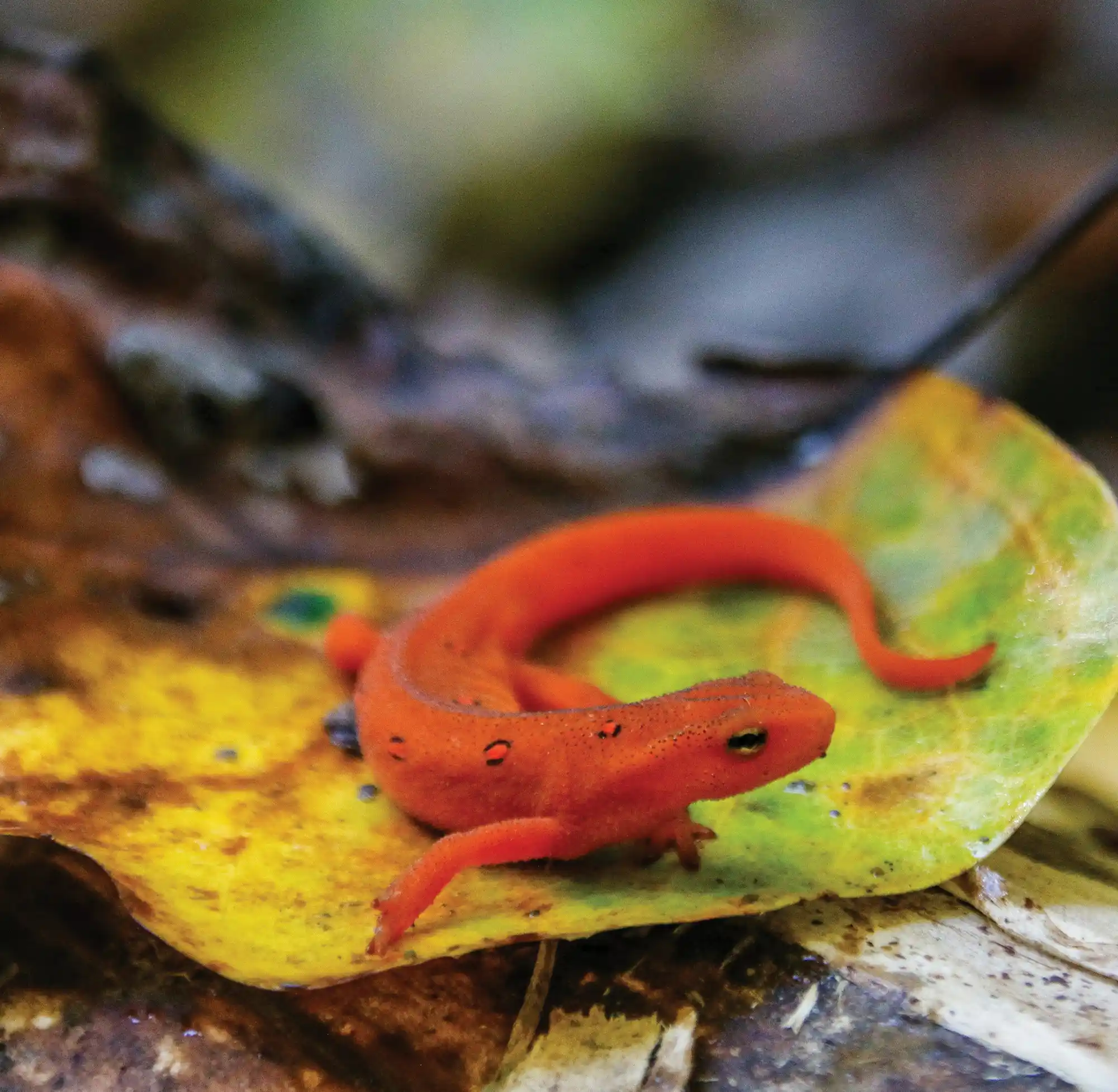
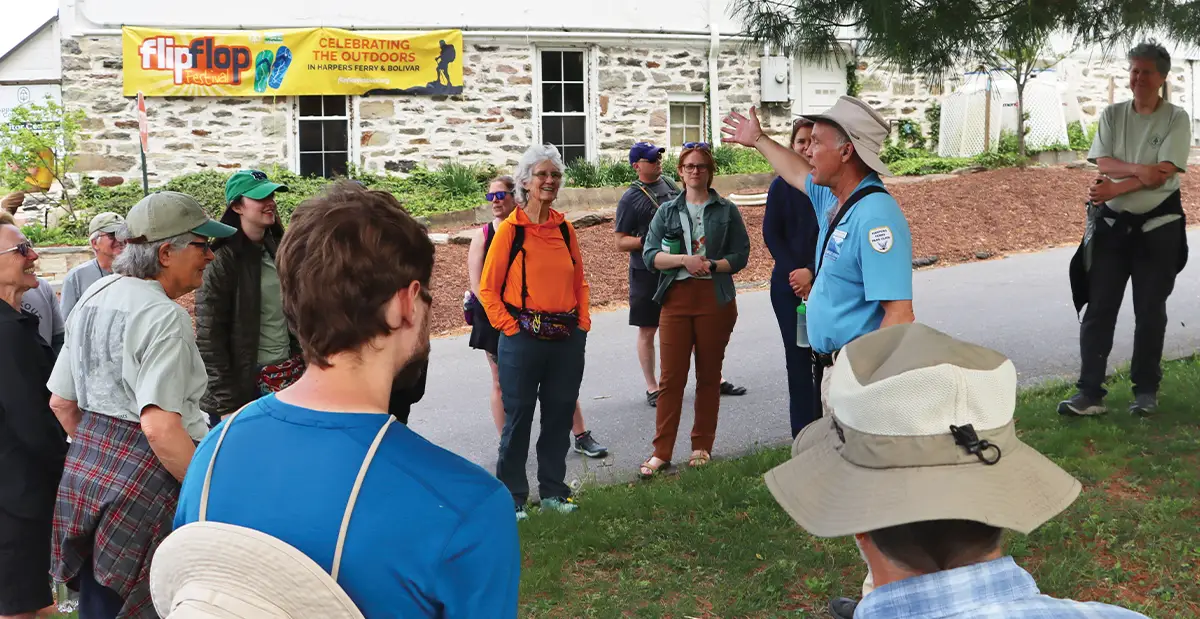
The weekend showcased the strength of the Trail community and the beauty of this alternative thru-hike. The ATC is thankful for its partners at the Trail & Town Alliance of Harpers Ferry-Bolivar; the A.T. Communities of Harpers Ferry and Bolivar, West Virginia, and Brunswick, Maryland; the Potomac Appalachian Trail Club; and River & Trails.
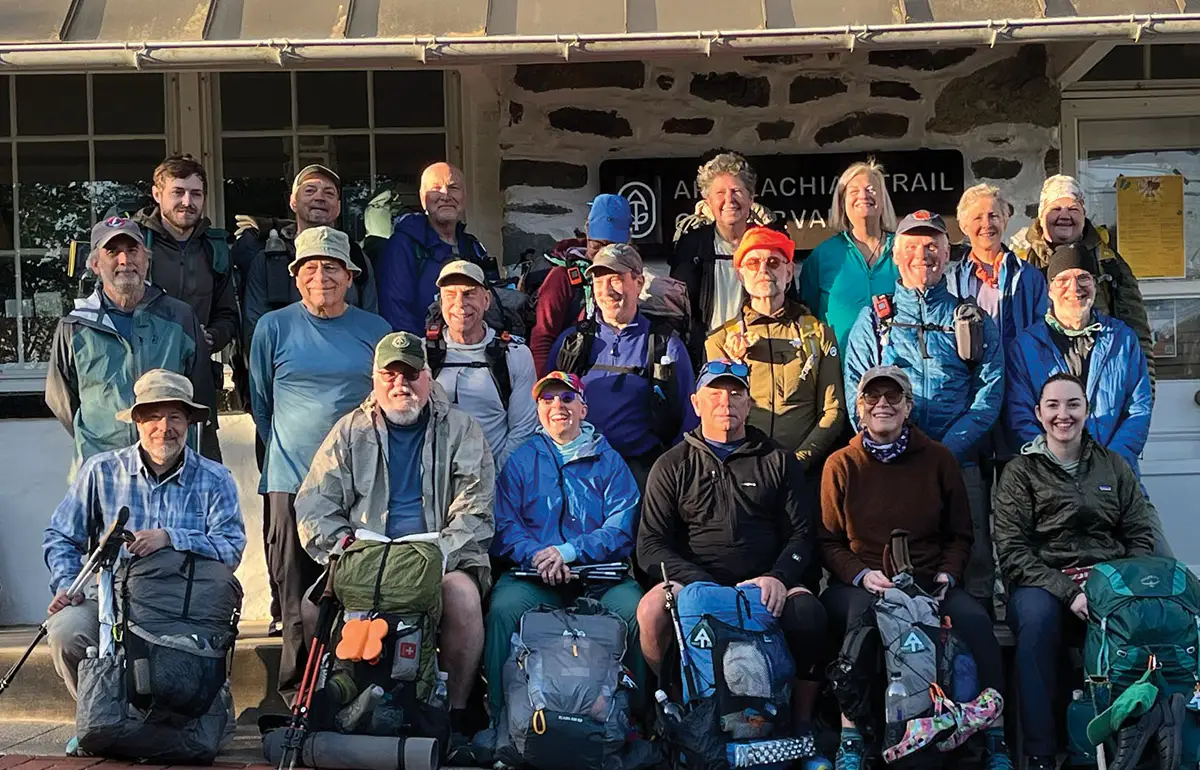
The 21 flip-flop thru-hikers gather in front of the Visitors Center before starting their journey. Photo by Caitlin Miller/ATC
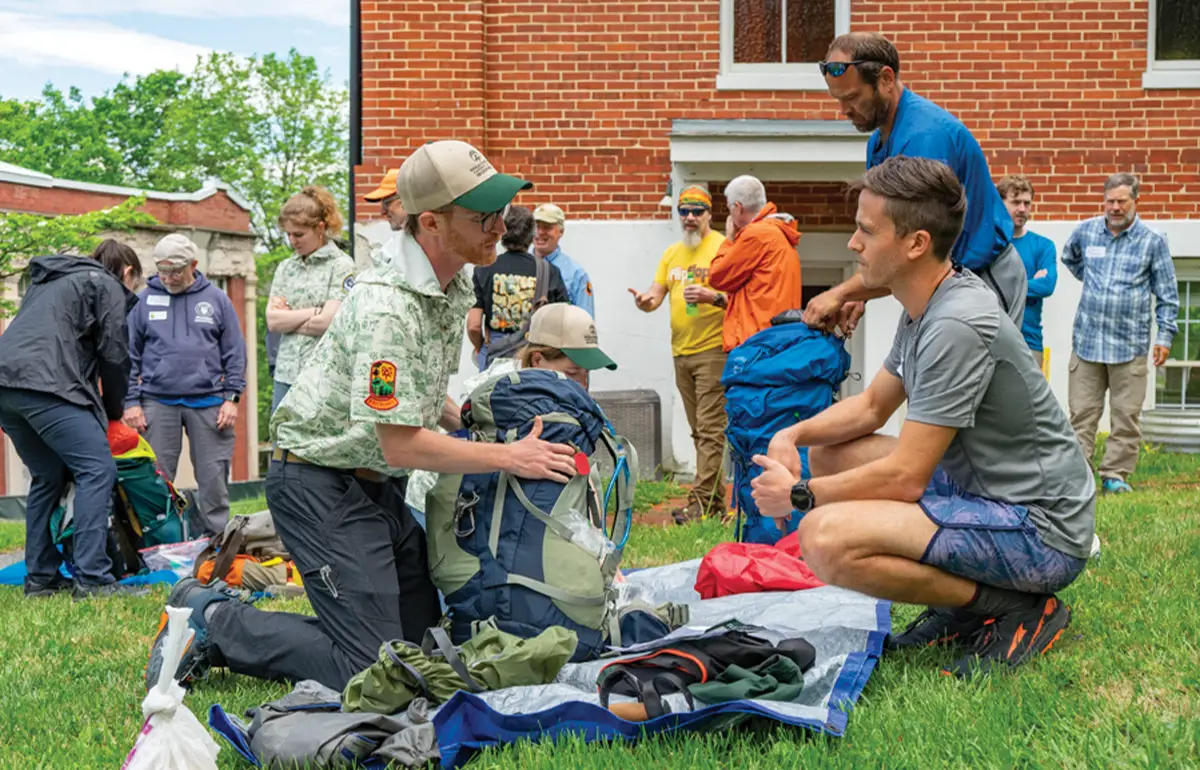
A volunteer from the Potomac Appalachian Trail Club helps a hiker shed pack weight. Photo by Andriana Barrios
The weekend showcased the strength of the Trail community and the beauty of this alternative thru-hike. The ATC is thankful for its partners at the Trail & Town Alliance of Harpers Ferry-Bolivar; the A.T. Communities of Harpers Ferry and Bolivar, West Virginia, and Brunswick, Maryland; the Potomac Appalachian Trail Club; and River & Trails.

The 21 flip-flop thru-hikers gather in front of the Visitors Center before starting their journey. Photo by Caitlin Miller/ATC

A volunteer from the Potomac Appalachian Trail Club helps a hiker shed pack weight. Photo by Andriana Barrios
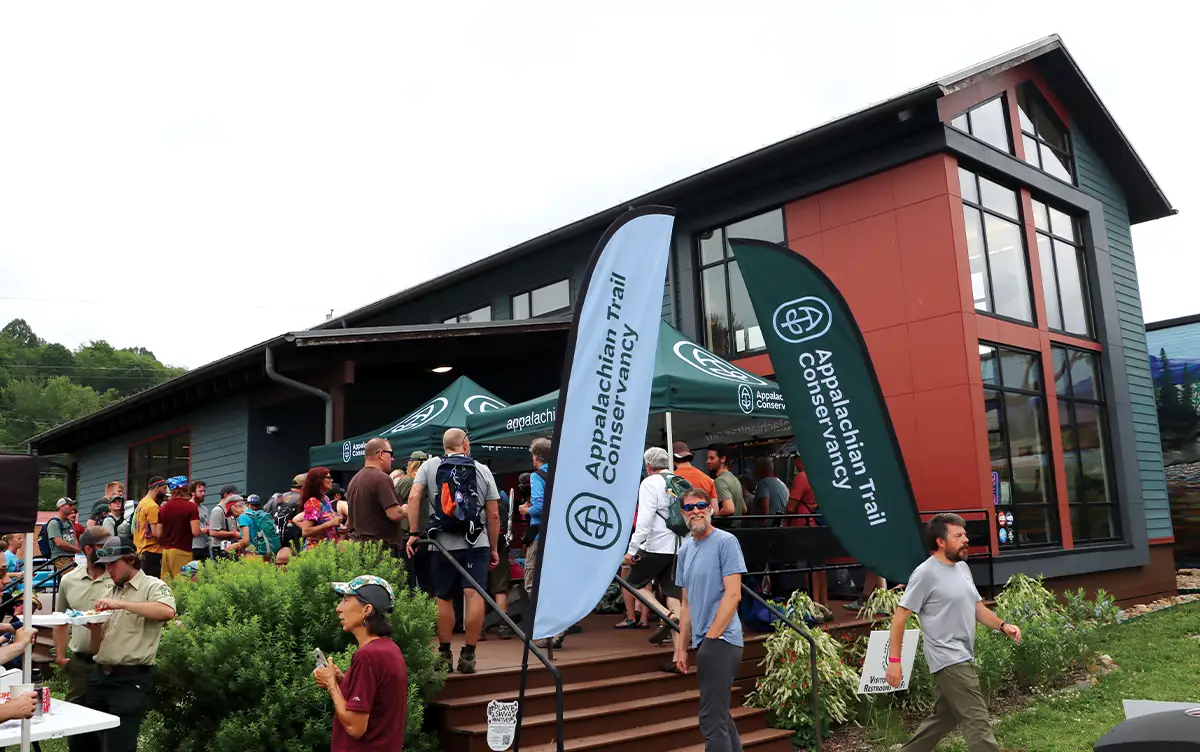
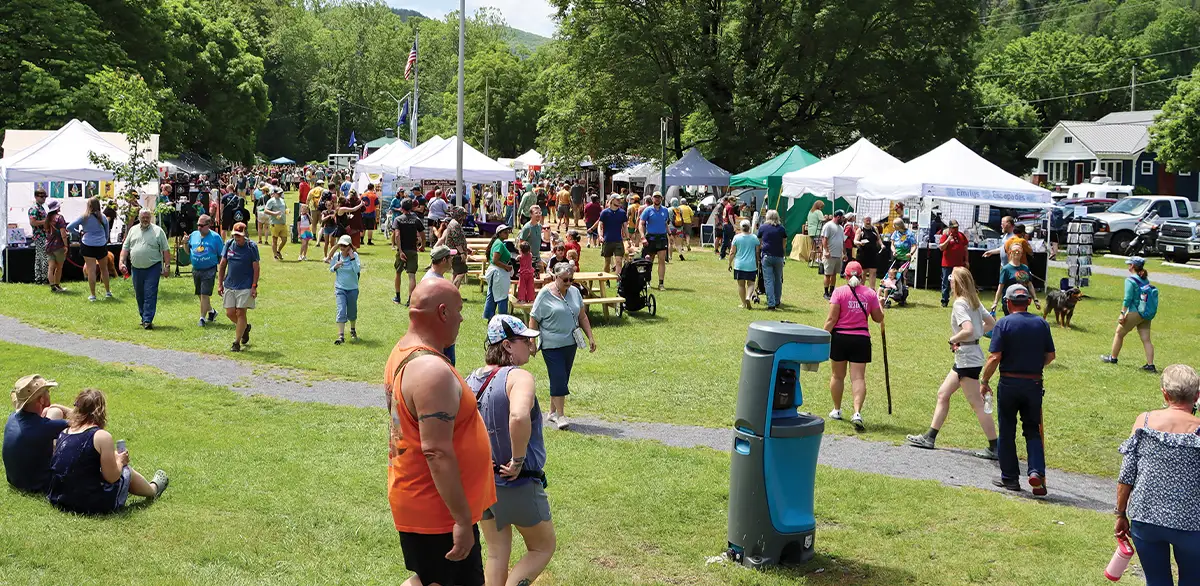
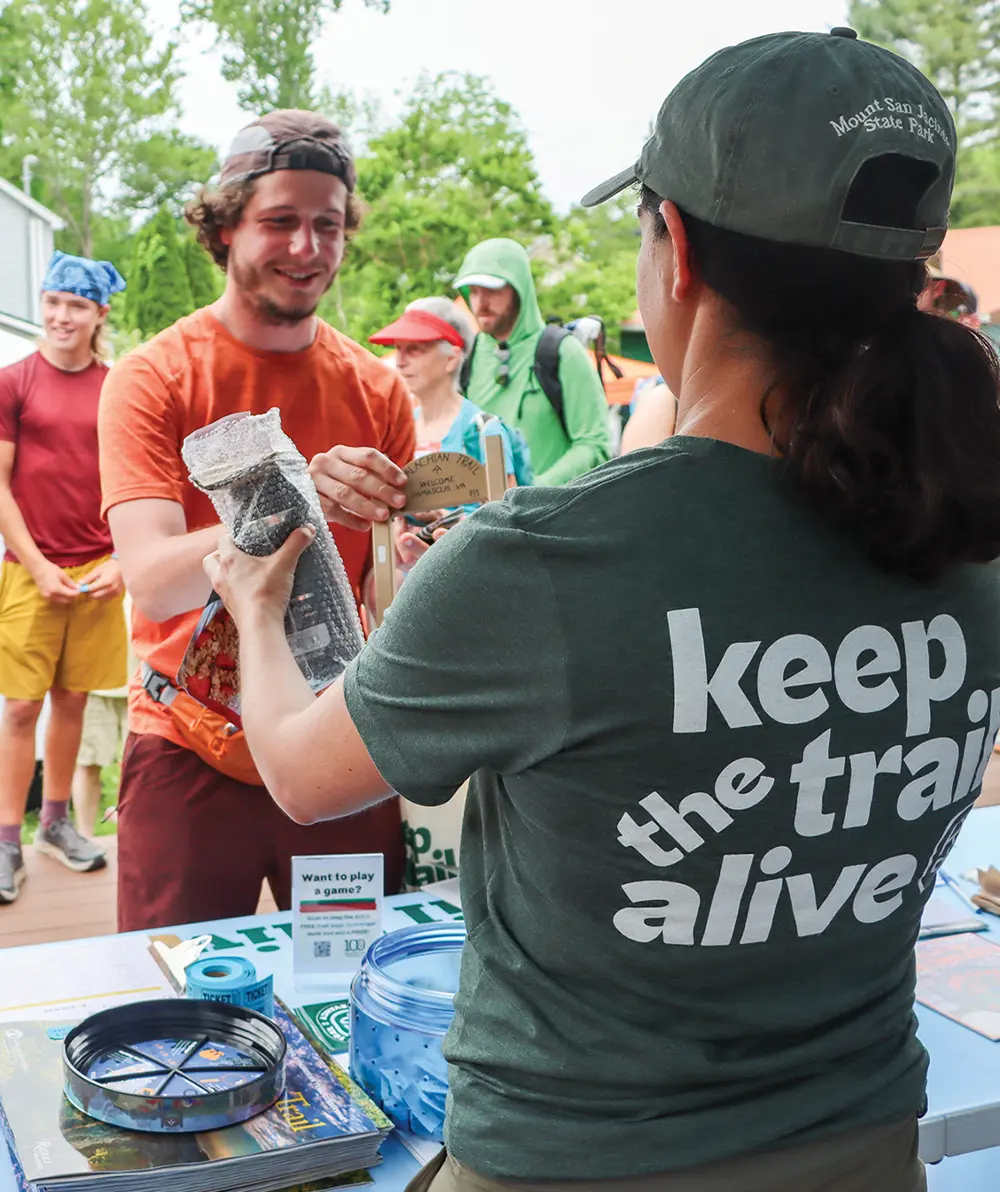
The ATC is grateful to Hike for Mental Health for their generous donation and to its partners who contributed to the raffles and tabled on the Trail Center lawn. This long-standing celebration of the A.T. was a fantastic opportunity to share passion for the Trail with ATC’s partners and visitors, and to welcome new and longtime members to the Damascus Trail Center.

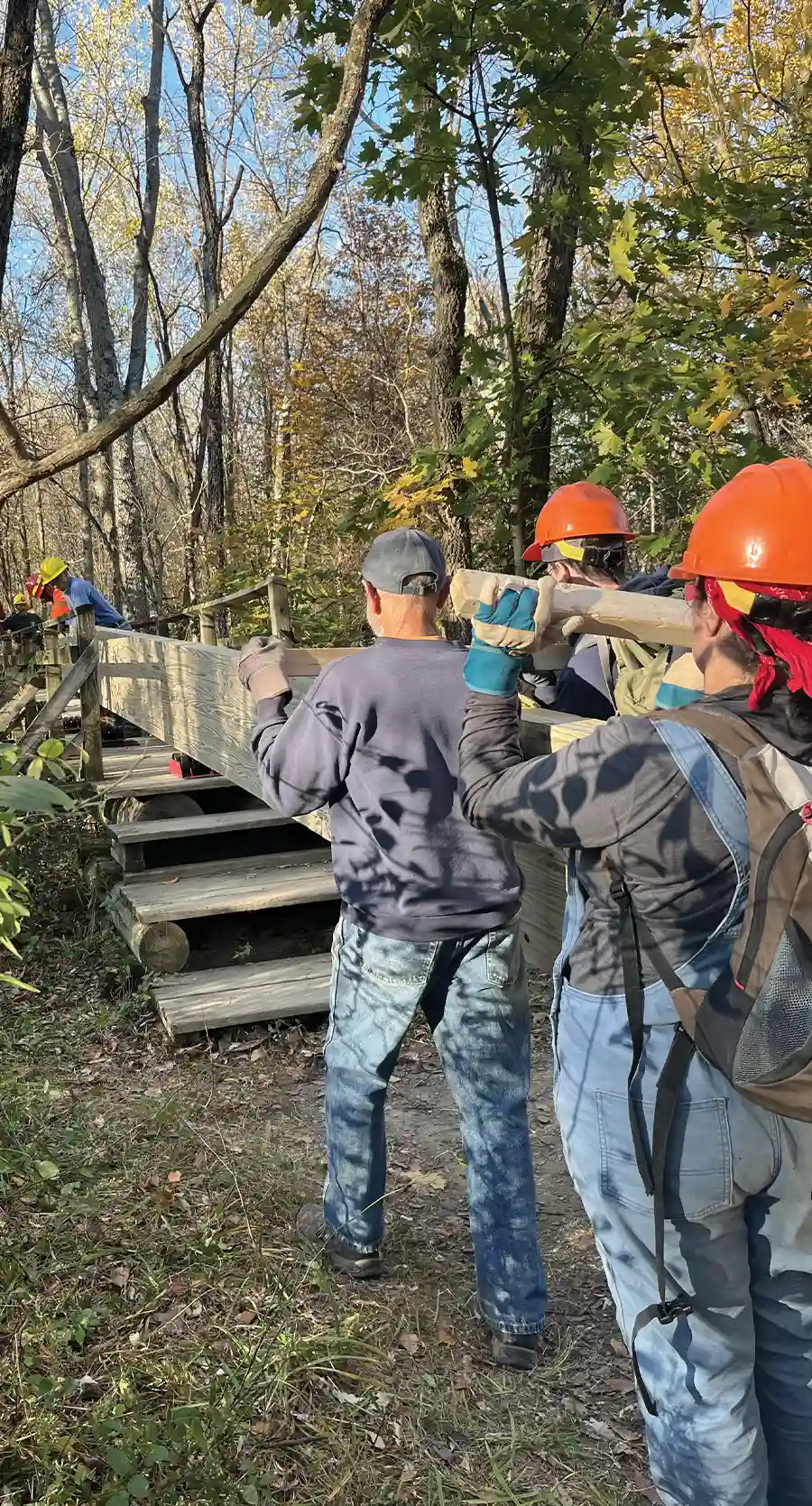
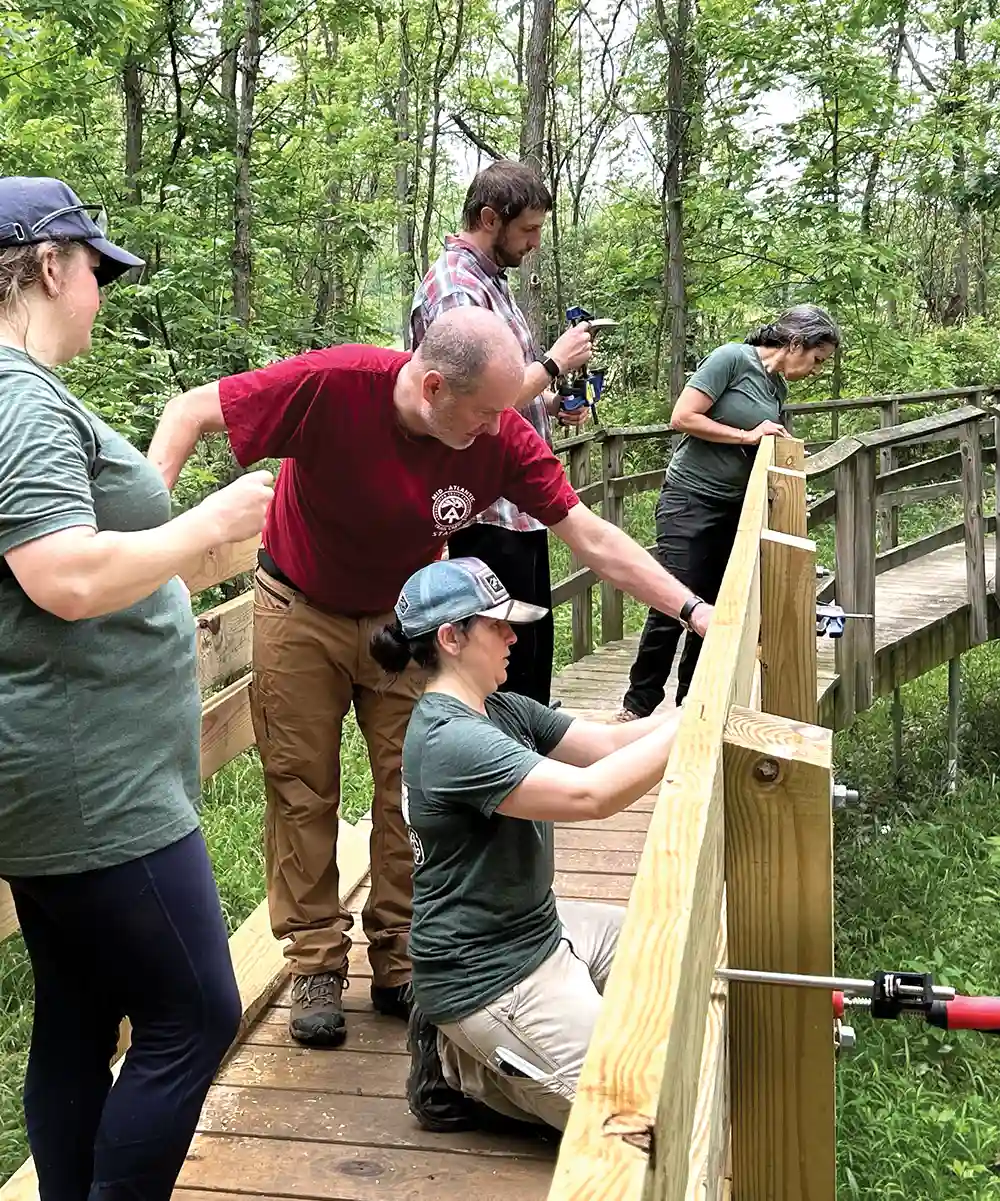
ATC staff work on the railings for the new bridge. Photo by Caroline Ralston/ATC
Over two weekends in October, almost 60 volunteers participated in this endeavor. Using a series of bars and straps, a log dolly, and equipment rollers on the foot bridges, Crew and Club members maneuvered their load about a half mile down the A.T. It was a slow, tedious process navigating the length and weight of the stringers (the beams that help support the bridge) around trees, curves in the Trail, and over water bars. The log dolly was extremely useful but had to be disassembled then reassembled at every bridge crossing.
During the bridge replacement, the CVATC had to reroute the Trail, which entailed building and installing a 19-foot temporary bridge. This was another successful volunteer effort that moved all the required materials so the bridge could be built on-site.
All of the work was an amazing team effort that could not have been accomplished without guidance from the ATC’s Bob Sickley, who managed the Mid-Atlantic Trail Crew, and Craig Dunn, the CVATC’s Trail Master, who coordinated all of the volunteers. The Mid-Atlantic Trail Crew worked their magic to get all stringers and decking boards in place. By mid-April, enough railing was installed to officially open the new bridge to the public. The temporary bridge was dismantled, and the Trail was routed back across the new bridge.
In June, more railing was added to the bridge — some of it completed by volunteers and ATC staff on their Staff Field Day in honor of National Trails Days. Later this year, more will be done to make parts of the bridge compliant with the Architectural Barriers Act (ABA). But the current progress is a great example of the vital work provided by a Maintaining Club and its volunteers and the collaborative efforts of those dedicated to the Appalachian Trail.
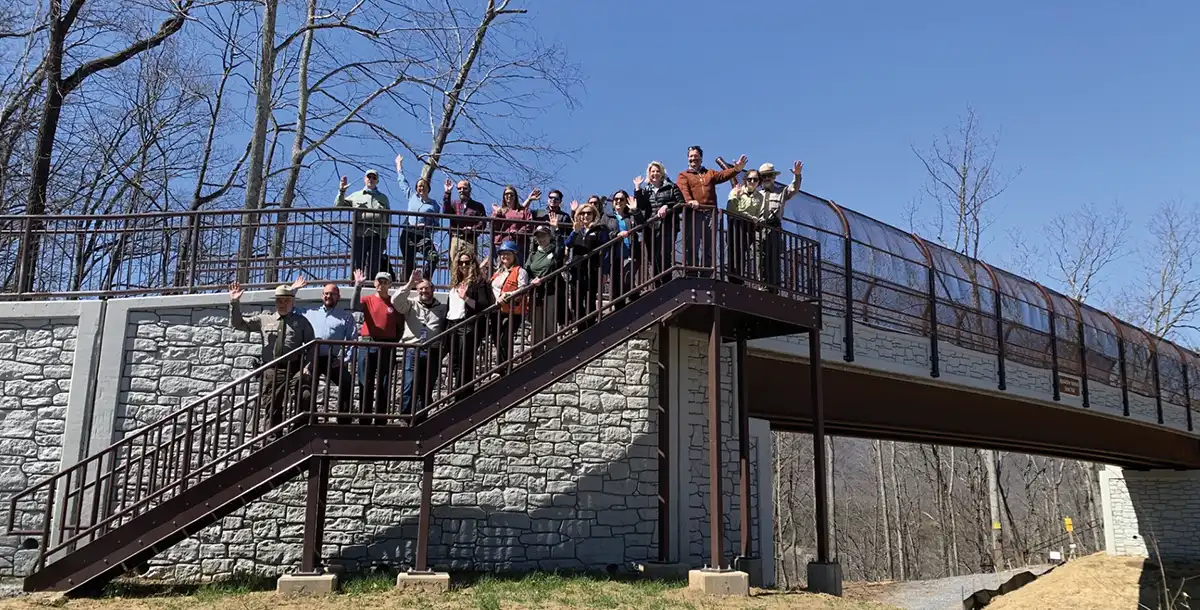
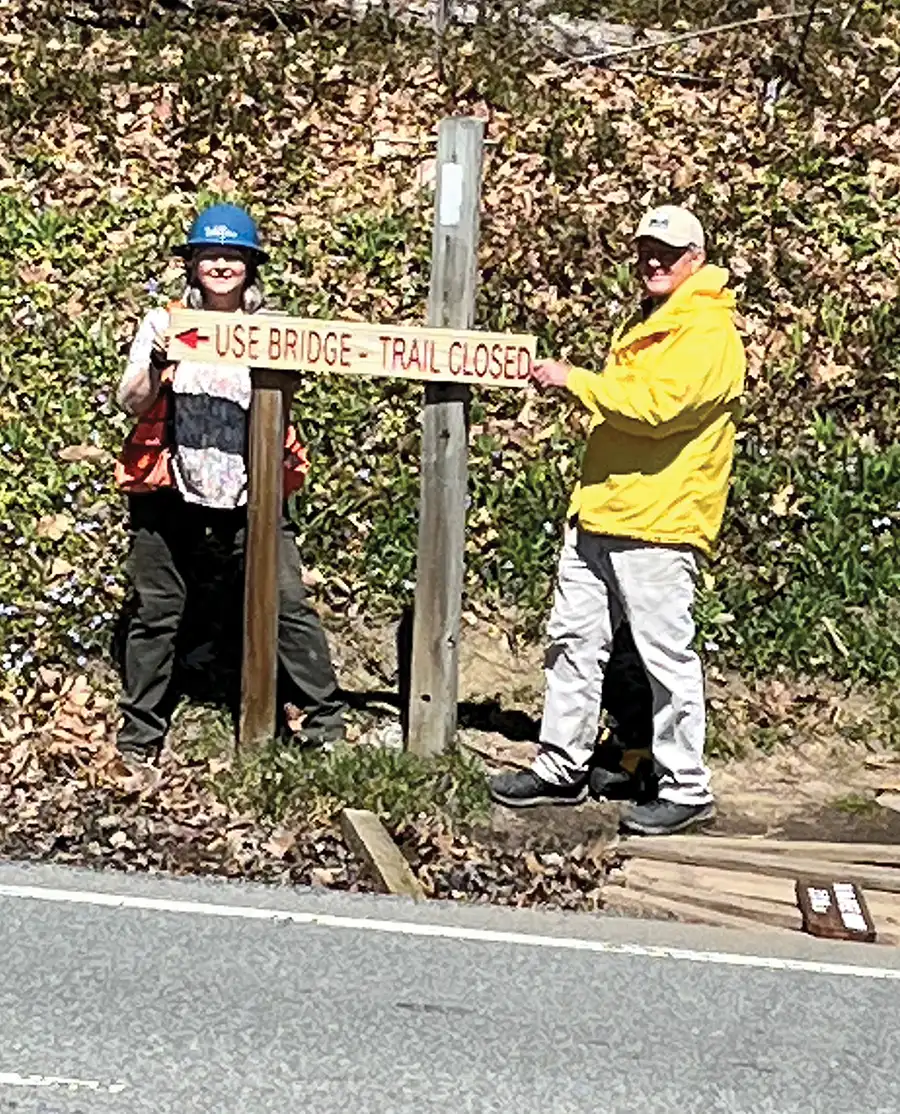
Linda and Kelly Mulheren install the sign rerouting hikers to the new crossing. Photo by Brian Boggs, RATC
One of the newest reroutes of the Appalachian Trail just may be one of the most spectacular. The Route 311 road crossing — by the McAfee Knob trailhead in Virginia — is now a part of the A.T. proudly maintained by the Roanoke Appalachian Trail Club (RATC). In the past, hikers had to make a mad dash across a dangerous stretch of the Trail: a curved, hilltop road where the speed limit is 55 mph. Hikers can now take their time and may even stop in the middle of the crossing above the busy road. The pedestrian bridge makes for a great hangout spot for day hikers, section hikers, and thru-hikers pausing to snack, snap a photo, or even take a break to chat with fellow Trail enthusiasts.
This portion of the A.T. — which is part of the Triple Crown segment of the A.T. that includes Dragon’s Tooth, McAfee Knob, and Tinker Cliffs — sees over 50,000 visitors per year. From planning to construction, the bridge took over 20 years to come to fruition. It was quite an accomplishment involving major input from a variety of agencies, including the Virginia Department of Transportation, local area governance, the Appalachian Trail Conservancy, the National Park Service, and the RATC. This cooperative management project was a huge challenge for all involved, but has resulted in a wonderful structure that brings a tremendous improvement to the Trail.
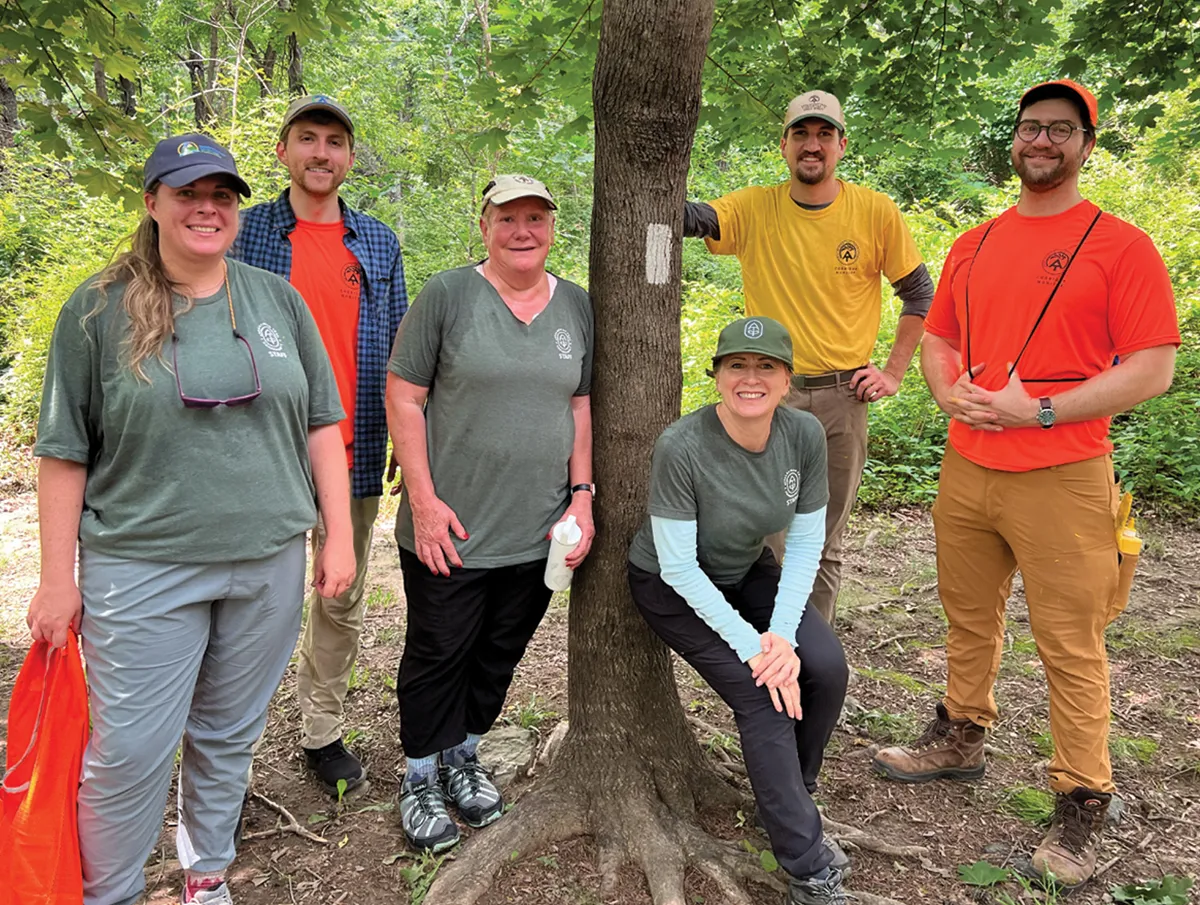
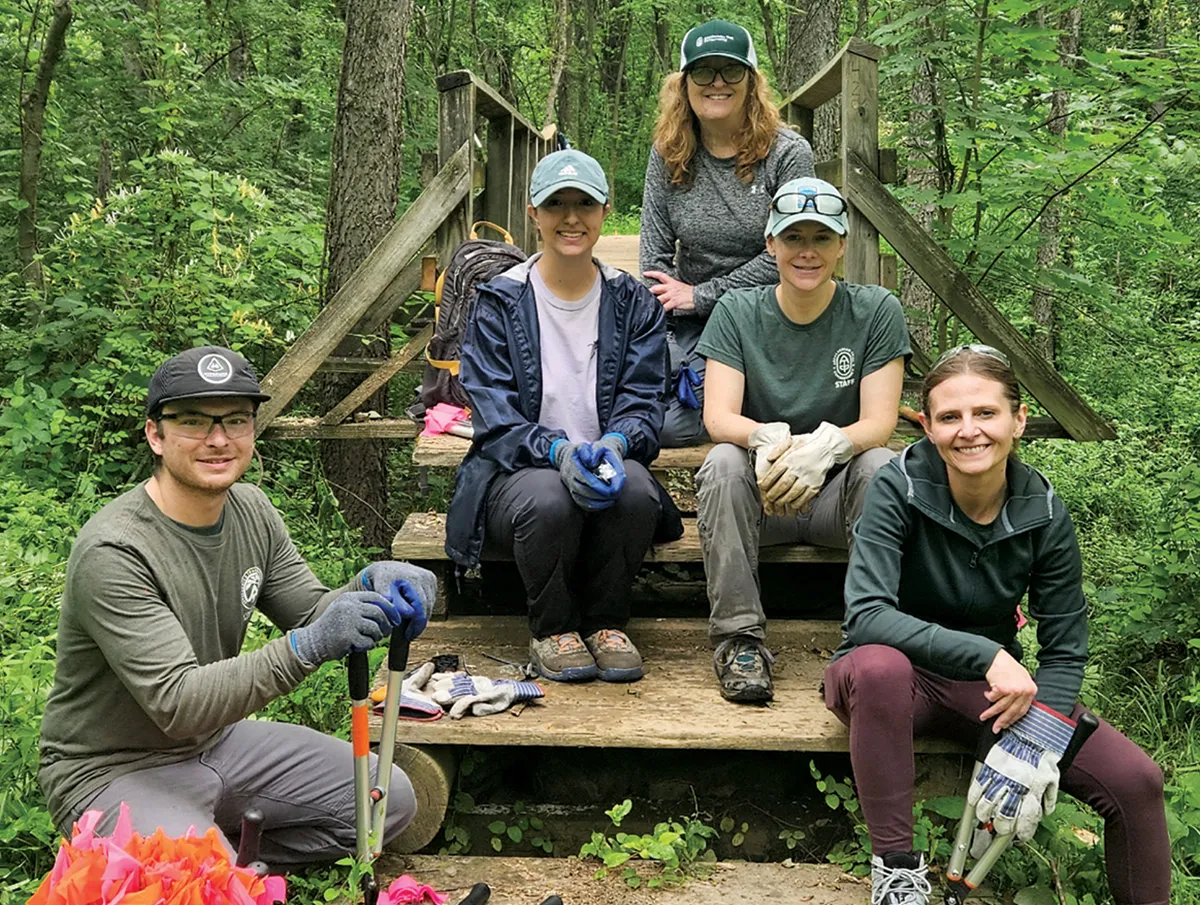
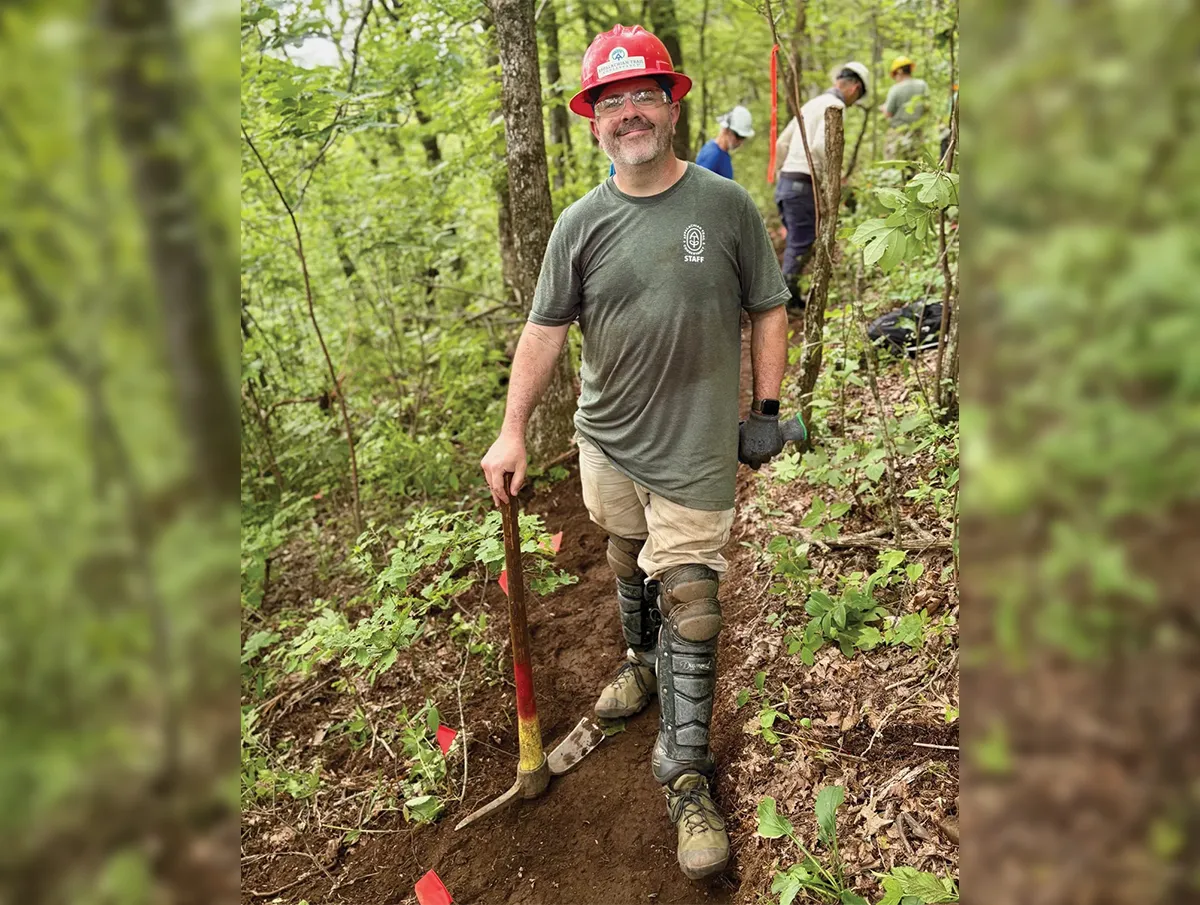
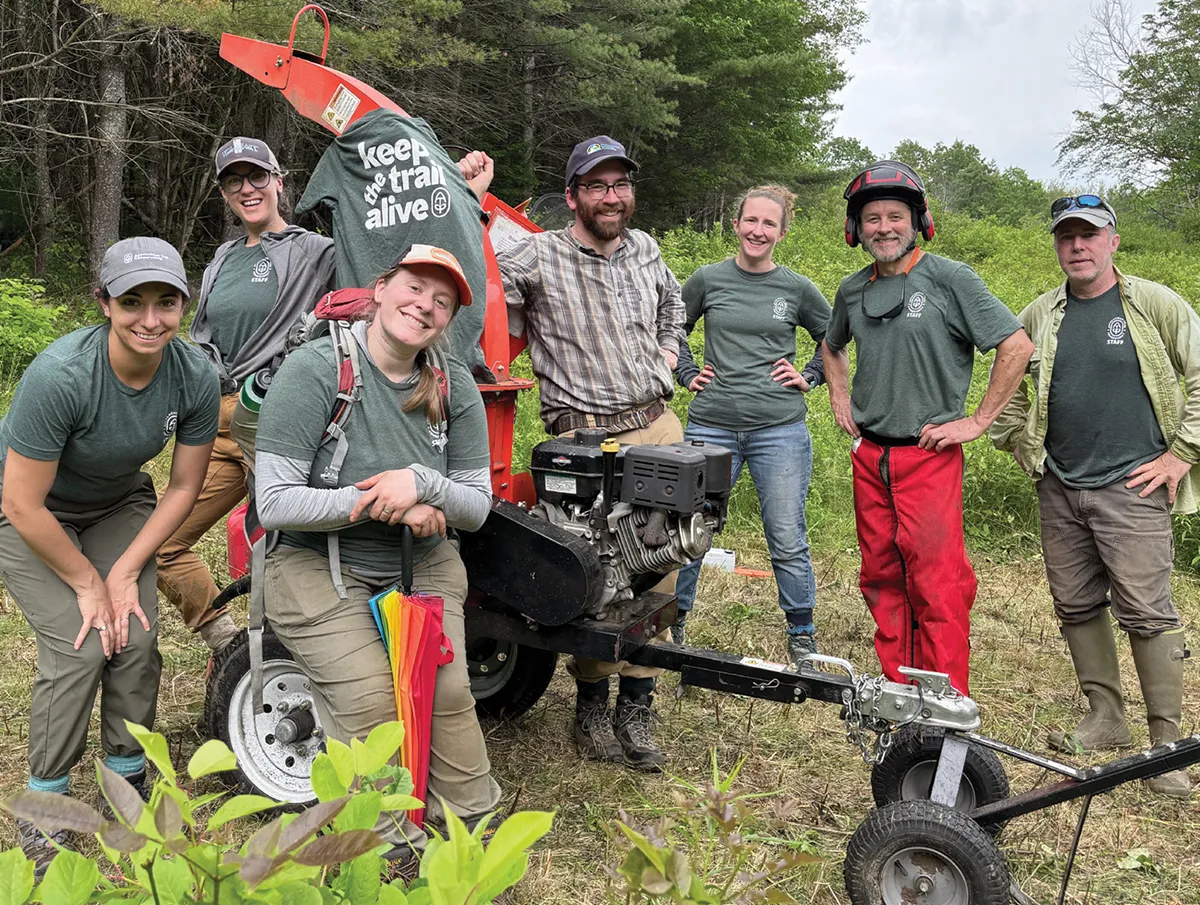
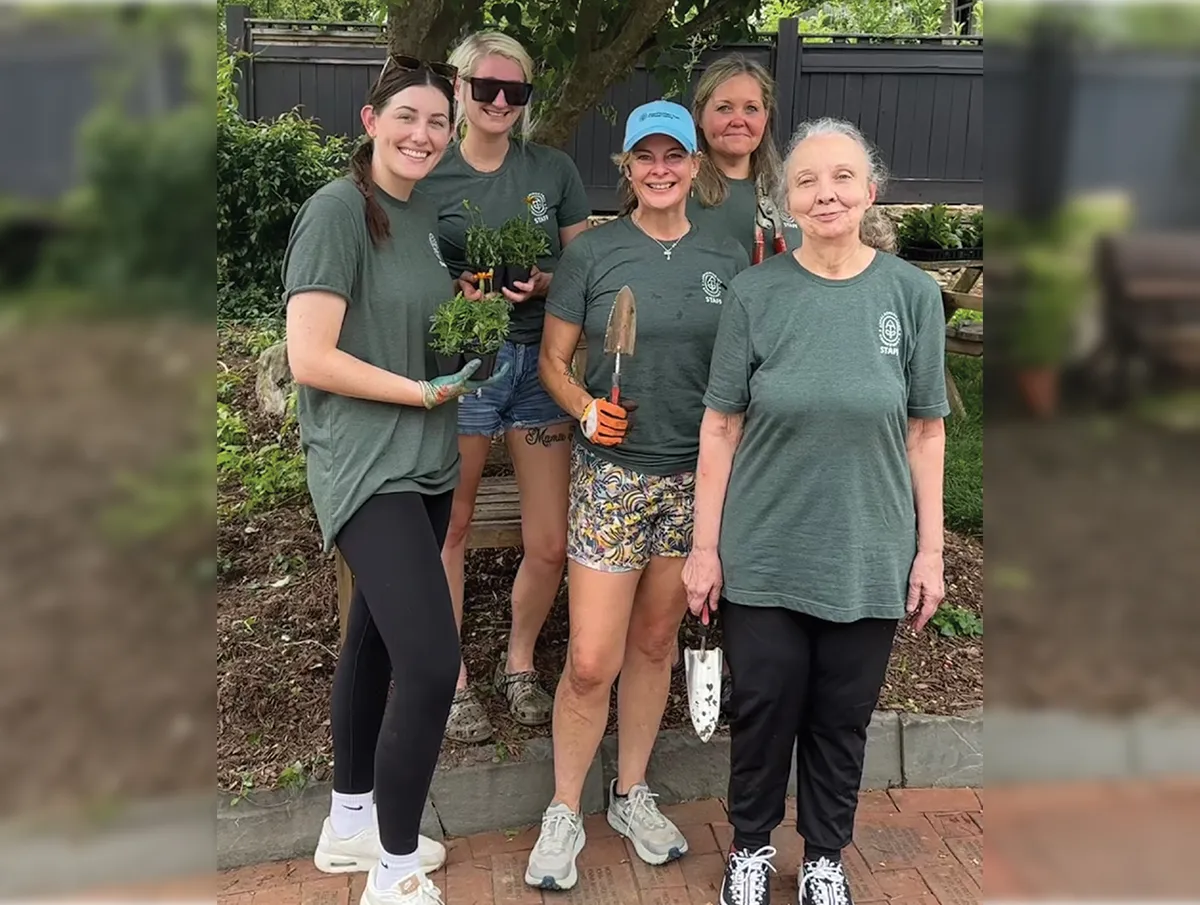
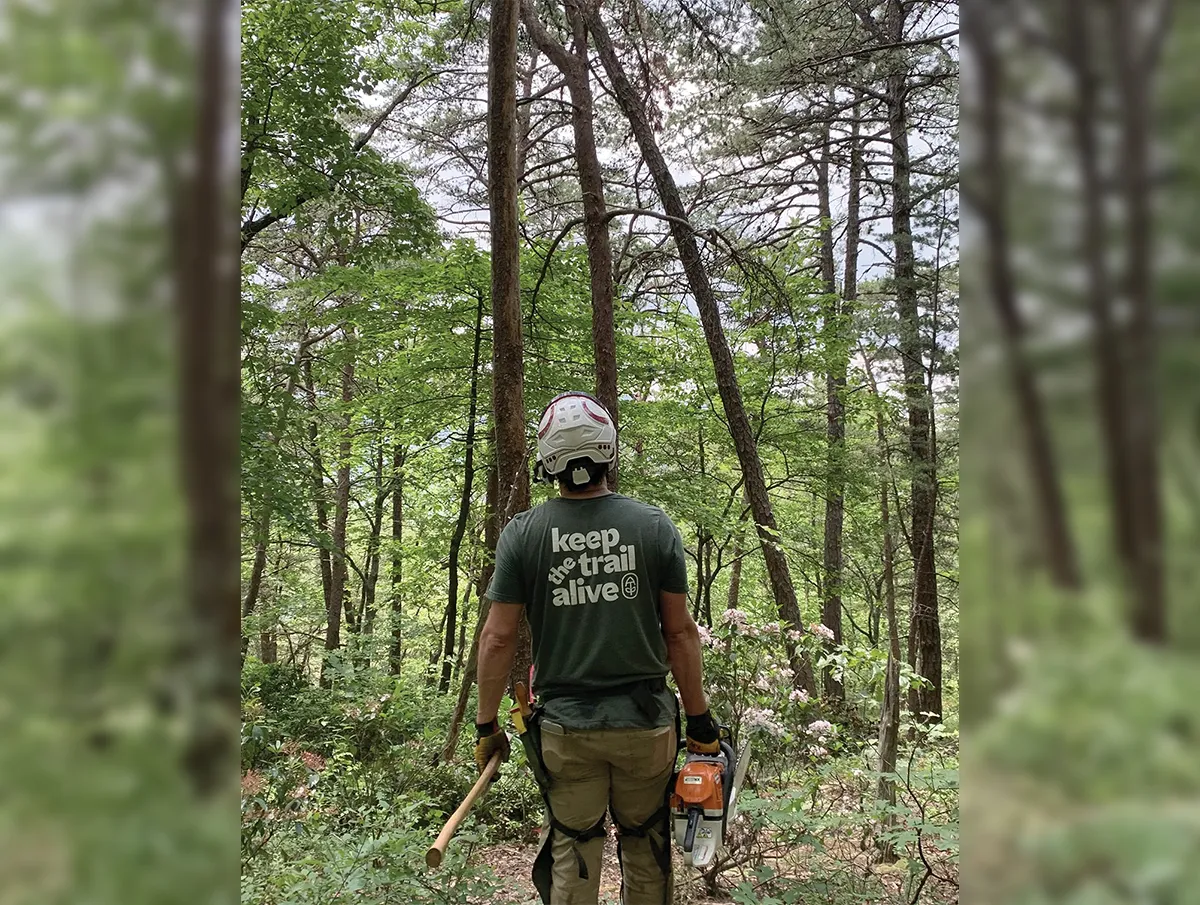
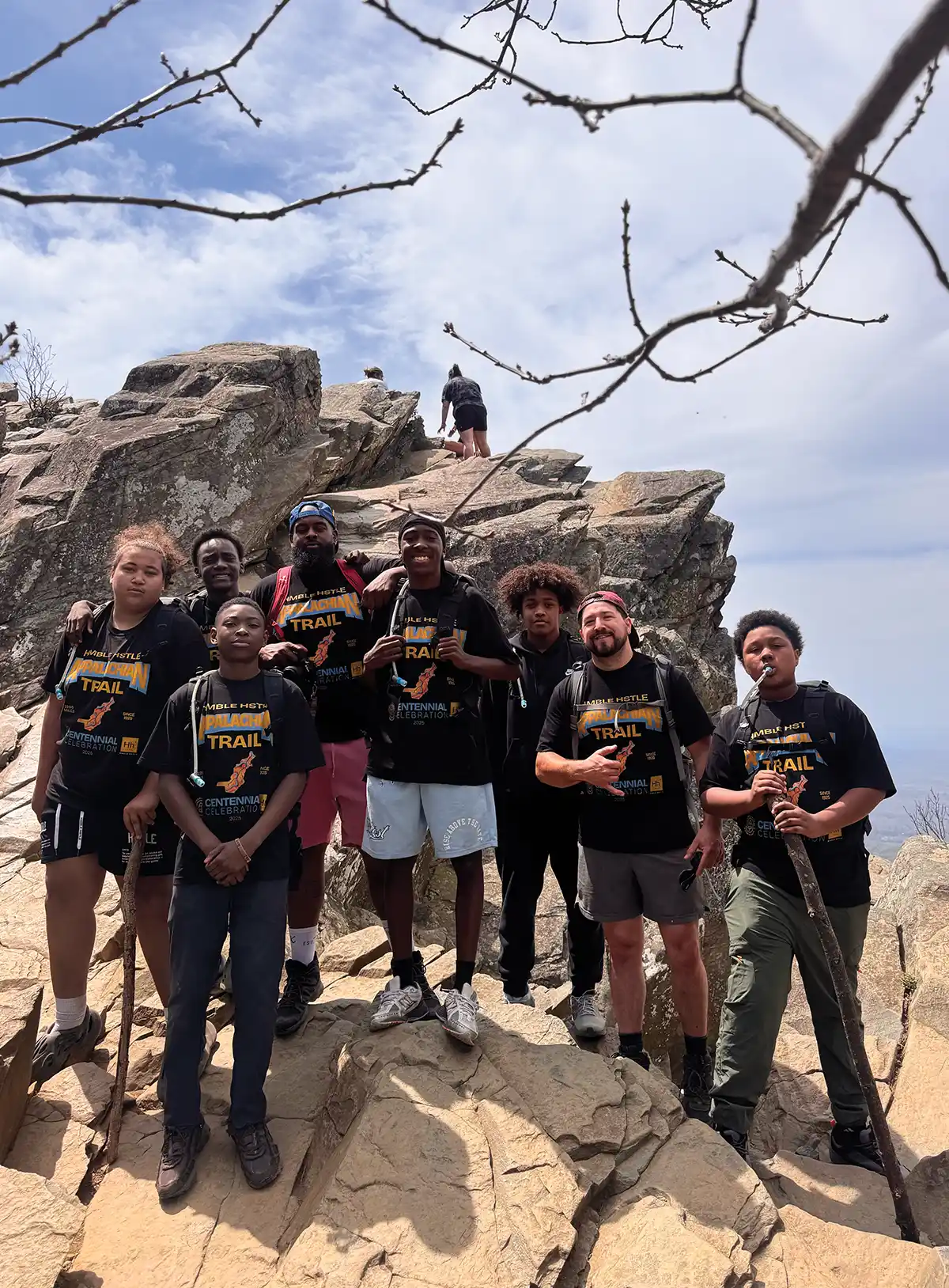
The Appalachian Trail Conservancy and HMBLE HSTLE Clothing have launched a collaborative collection — “Beyond Us” — celebrating 100 years of the Appalachian Trail’s legacy. Merging streetwear with outdoor culture, the pieces emphasize the importance of nature, community, and East Coast pride. Pieces are available now in the ATC Trail Store and additional apparel will be available throughout the year.
HMBLE HSTLE Clothing began as a way to fund the Humble Hustle nonprofit, an organization that provides programming for Roanoke youth. All sales of HMBLE HSTLE x ATC merchandise will advance the ATC’s mission and Humble Hustle’s efforts to provide pathways for youth to experience and connect with nature and the outdoors.
The meeting is an opportunity to come together as a community to discuss the future of the ATC and recommit to educating and empowering current and future caretakers of the Appalachian Trail. The meeting will be live-streamed and all members are invited to participate.
The results of the 2025 Board of Directors election will be announced at the meeting. The slate of candidates will be published on the ATC website prior to the meeting, and all members whose membership is current as of August 1, 2025, are eligible to vote. Members will receive an email to cast their ballot online.
For more information, visit appalachiantrail.org/2025meeting

ATC’s Centennial Gala fills the East Hall of Union Station with celebration and shared commitment to the Trail’s next 100 years. Photos by Ken Pak Photography
More than 200 guests gathered at Washington, D.C.’s Union Station to celebrate the Appalachian Trail Conservancy’s 100 years of dedication to the Appalachian National Scenic Trail (A.T.), and the legacy of conservation, education, and advocacy that has shaped the Trail into a cultural and environmental treasure. The evening brought together trailblazers, stewards, policymakers, and supporters to honor the Trail’s impact and chart its future.
Heading into its second century, the ATC continues to focus on three core pillars: Protect, Experience, and Belong. At the Gala, the Centennial Awards of Excellence recognized individuals and organizations that honor the pillars’ values: Protect honors efforts to conserve the Trail’s landscapes through stewardship and advocacy, including support for the Appalachian Trail Centennial Act. Honorees: Sen. Tim Kaine, D-VA; Sen. Thom Tillis, R-NC; Rep. Don Beyer, D-VA; Rep. Mike Lawler, R-NY. Experience highlights efforts to enhance how people engage with the Trail. Honoree: L.L.Bean, for its enduring support of outdoor recreation and stewardship. Belong celebrates work to make the Trail inclusive and welcoming. Honoree: Dr. Mamie Parker, for her leadership in conservation and environmental education.
During the Gala, author and adventurer Jennifer Pharr Davis moderated a fireside chat with entrepreneur, co-founder of Whole Foods, philanthropist, and A.T. thru-hiker John Mackey. In addition, Dr. Mills Kelly — professor emeritus at George Mason University and historian of the Appalachian Trail — presented a look back on the last 100 years of the ATC.
Gratitude was expressed to ATC’s vital federal partners, including the National Park Service and U.S. Forest Service, for their enduring collaboration in protecting the A.T. Deep appreciation was also extended to the 30 Trail Maintaining Clubs — the heart and soul of the A.T. — whose volunteers carry out the daily, hands-on work of keeping the Trail open and thriving. The Potomac Appalachian Trail Club (PATC) was specially honored as the Centennial Gala’s Tribute Partner. Founded in 1927 by a small group that included legendary Trail leader Myron Avery, today PATC’s stewardship spans more than 240 miles of the Trail across four states. PATC’s legacy of volunteerism exemplifies the enduring spirit of the Trail and reminds us that behind every white blaze is a story of dedication, community, and care.
The Volgenau Foundation was honored with a Partnership Tribute for its commitment to conservation and their transformative and ongoing support of the A.T., high value ecosystems, watersheds, and scenic vistas. More than ten years ago, the Appalachian Trail Landscape Partnership (ATLP) was formed with a mission to provide permanent protection of highly valued areas within the A.T. landscape. Thanks to a generous gift from the Volgenau Foundation, the ATLP was able to not only convene its first meeting but has grown and thrived. More than 88,000 acres have been conserved through the ATLP network across eleven states. The ATLP’s Wild East Action Fund has leveraged more than $80 million from partner organizations to amplify on-the-ground conservation efforts.
Recognition was also given to SAIC — a premier Fortune 500 company — for their annual support of the ATC’s work under both the Experience and Belong pillars. In addition, for the past two Earth Days, they have encouraged their entire staff of roughly 24,000 to fundraise for the ATC, matching dollars raised by employees and helping to build a new generation of Trail enthusiasts.
The ATC is committed to empowering the next generation of trail stewards — the future of A.T. advocacy and leadership — and has partnered with leading organizations with reach and access to youth, young adult, and underrepresented groups. The Greening Youth Foundation based in Atlanta was highlighted as being key to supporting future environmental advocates and stewards.
The ATC also announced the public launch of its Centennial Campaign, the largest fundraising effort in the organization’s history, with a goal of raising $50 million over five years to secure the Appalachian National Scenic Trail’s future for generations to come. (For more about the Campaign please see “Securing the Trail’s Future.”)
The ATC extends its gratitude to all supporters, partners, and volunteers who have contributed to the success of the Centennial Gala and the ongoing mission to protect and preserve the Appalachian Trail for future generations.
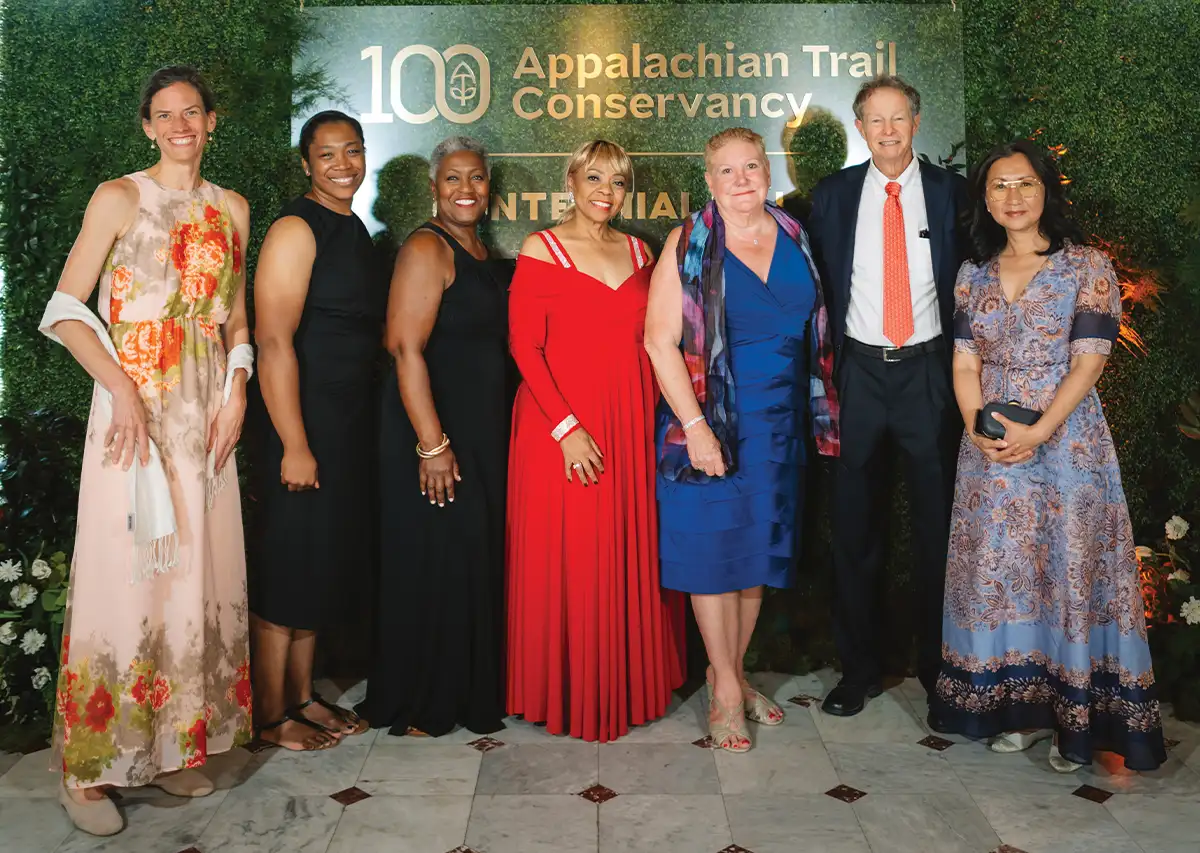
Jennifer Pharr Davis, Gala Speaker; Eboni Preston Goddard, ATC Board Member; Renee Alston-Maisonet, ATC Board Member; Dr. Mamie Parker, Honoree; Sandra L. Marra, ATC President & CEO; John Mackey, Gala Speaker; Yong Lee, ATC Board Member
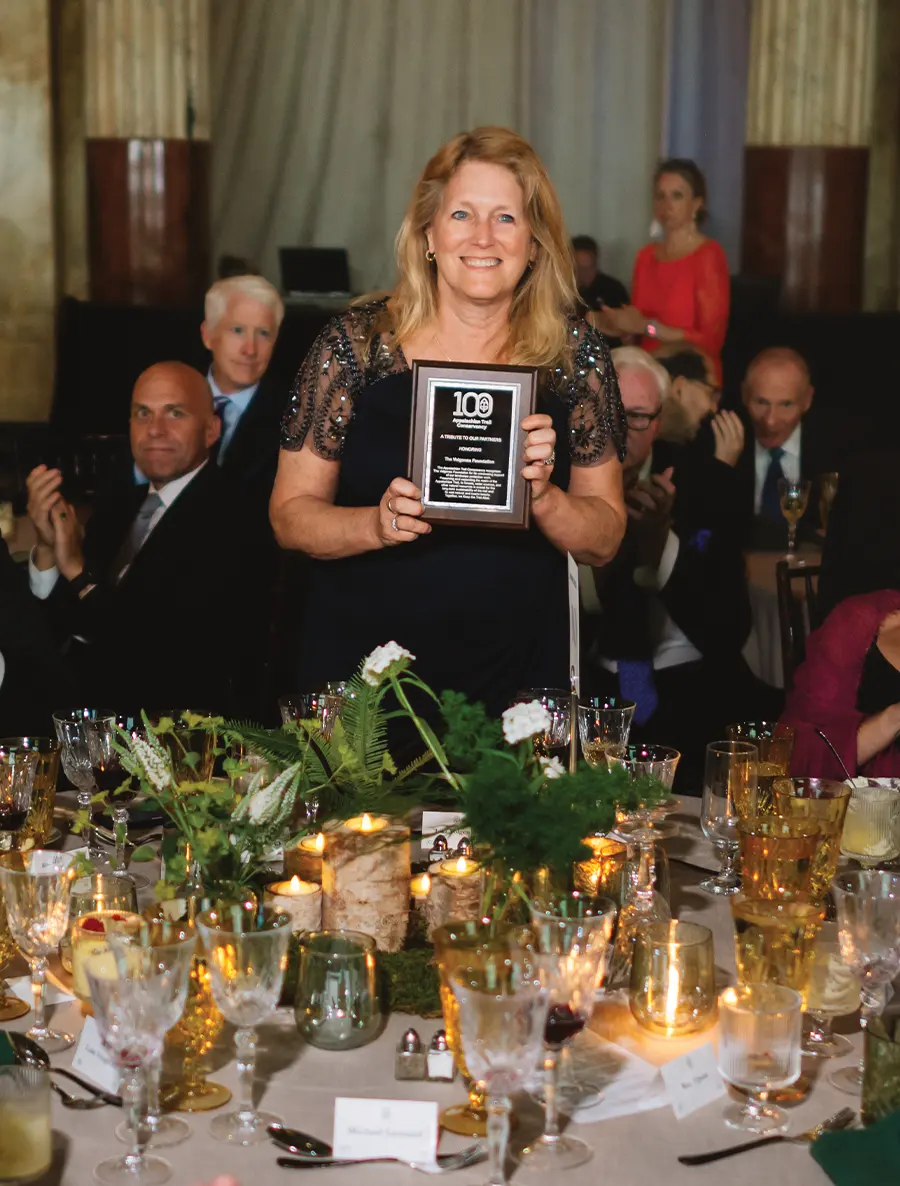
Lisa Volgenau, VP of The Volgenau Foundation Board of Directors, accepts a tribute in honor of the Foundation’s exceptional support of Appalachian Trail landscape conservation.
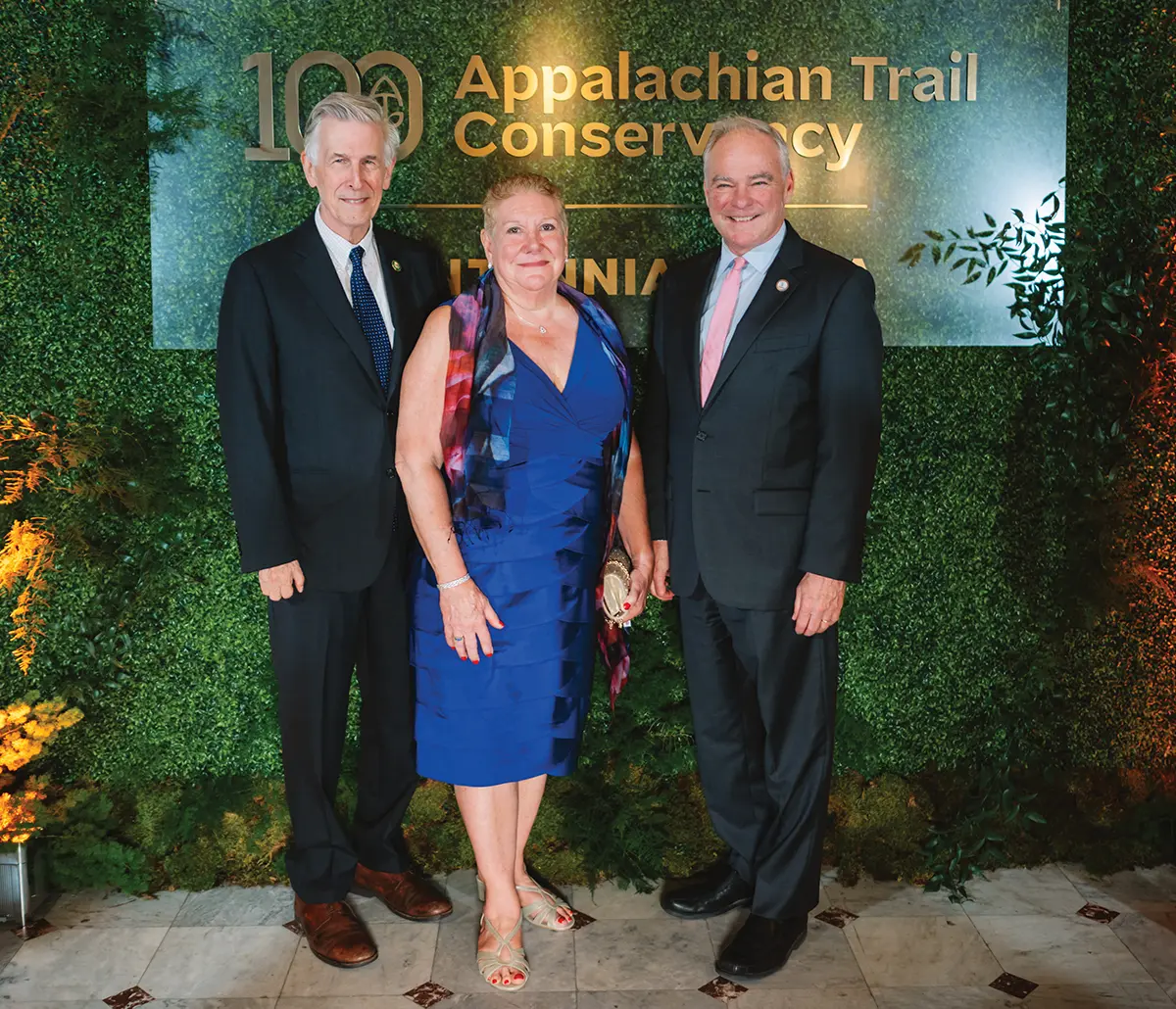
Congressman Don Beyer, Sandra L. Marra, and Senator Tim Kaine

ATC’s Centennial Gala fills the East Hall of Union Station with celebration and shared commitment to the Trail’s next 100 years. Photos by Ken Pak Photography
More than 200 guests gathered at Washington, D.C.’s Union Station to celebrate the Appalachian Trail Conservancy’s 100 years of dedication to the Appalachian National Scenic Trail (A.T.), and the legacy of conservation, education, and advocacy that has shaped the Trail into a cultural and environmental treasure. The evening brought together trailblazers, stewards, policymakers, and supporters to honor the Trail’s impact and chart its future.
Heading into its second century, the ATC continues to focus on three core pillars: Protect, Experience, and Belong. At the Gala, the Centennial Awards of Excellence recognized individuals and organizations that honor the pillars’ values: Protect honors efforts to conserve the Trail’s landscapes through stewardship and advocacy, including support for the Appalachian Trail Centennial Act. Honorees: Sen. Tim Kaine, D-VA; Sen. Thom Tillis, R-NC; Rep. Don Beyer, D-VA; Rep. Mike Lawler, R-NY. Experience highlights efforts to enhance how people engage with the Trail. Honoree: L.L.Bean, for its enduring support of outdoor recreation and stewardship. Belong celebrates work to make the Trail inclusive and welcoming. Honoree: Dr. Mamie Parker, for her leadership in conservation and environmental education.
During the Gala, author and adventurer Jennifer Pharr Davis moderated a fireside chat with entrepreneur, co-founder of Whole Foods, philanthropist, and A.T. thru-hiker John Mackey. In addition, Dr. Mills Kelly — professor emeritus at George Mason University and historian of the Appalachian Trail — presented a look back on the last 100 years of the ATC.
Gratitude was expressed to ATC’s vital federal partners, including the National Park Service and U.S. Forest Service, for their enduring collaboration in protecting the A.T. Deep appreciation was also extended to the 30 Trail Maintaining Clubs — the heart and soul of the A.T. — whose volunteers carry out the daily, hands-on work of keeping the Trail open and thriving. The Potomac Appalachian Trail Club (PATC) was specially honored as the Centennial Gala’s Tribute Partner. Founded in 1927 by a small group that included legendary Trail leader Myron Avery, today PATC’s stewardship spans more than 240 miles of the Trail across four states. PATC’s legacy of volunteerism exemplifies the enduring spirit of the Trail and reminds us that behind every white blaze is a story of dedication, community, and care.
The Volgenau Foundation was honored with a Partnership Tribute for its commitment to conservation and their transformative and ongoing support of the A.T., high value ecosystems, watersheds, and scenic vistas. More than ten years ago, the Appalachian Trail Landscape Partnership (ATLP) was formed with a mission to provide permanent protection of highly valued areas within the A.T. landscape. Thanks to a generous gift from the Volgenau Foundation, the ATLP was able to not only convene its first meeting but has grown and thrived. More than 88,000 acres have been conserved through the ATLP network across eleven states. The ATLP’s Wild East Action Fund has leveraged more than $80 million from partner organizations to amplify on-the-ground conservation efforts.
Recognition was also given to SAIC — a premier Fortune 500 company — for their annual support of the ATC’s work under both the Experience and Belong pillars. In addition, for the past two Earth Days, they have encouraged their entire staff of roughly 24,000 to fundraise for the ATC, matching dollars raised by employees and helping to build a new generation of Trail enthusiasts.
The ATC is committed to empowering the next generation of trail stewards — the future of A.T. advocacy and leadership — and has partnered with leading organizations with reach and access to youth, young adult, and underrepresented groups. The Greening Youth Foundation based in Atlanta was highlighted as being key to supporting future environmental advocates and stewards.
The ATC also announced the public launch of its Centennial Campaign, the largest fundraising effort in the organization’s history, with a goal of raising $50 million over five years to secure the Appalachian National Scenic Trail’s future for generations to come. (For more about the Campaign please see “Securing the Trail’s Future.”)
The ATC extends its gratitude to all supporters, partners, and volunteers who have contributed to the success of the Centennial Gala and the ongoing mission to protect and preserve the Appalachian Trail for future generations.

Jennifer Pharr Davis, Gala Speaker; Eboni Preston Goddard, ATC Board Member; Renee Alston-Maisonet, ATC Board Member; Dr. Mamie Parker, Honoree; Sandra L. Marra, ATC President & CEO; John Mackey, Gala Speaker; Yong Lee, ATC Board Member

Lisa Volgenau, VP of The Volgenau Foundation Board of Directors, accepts a tribute in honor of the Foundation’s exceptional support of Appalachian Trail landscape conservation.

Congressman Don Beyer, Sandra L. Marra, and Senator Tim Kaine
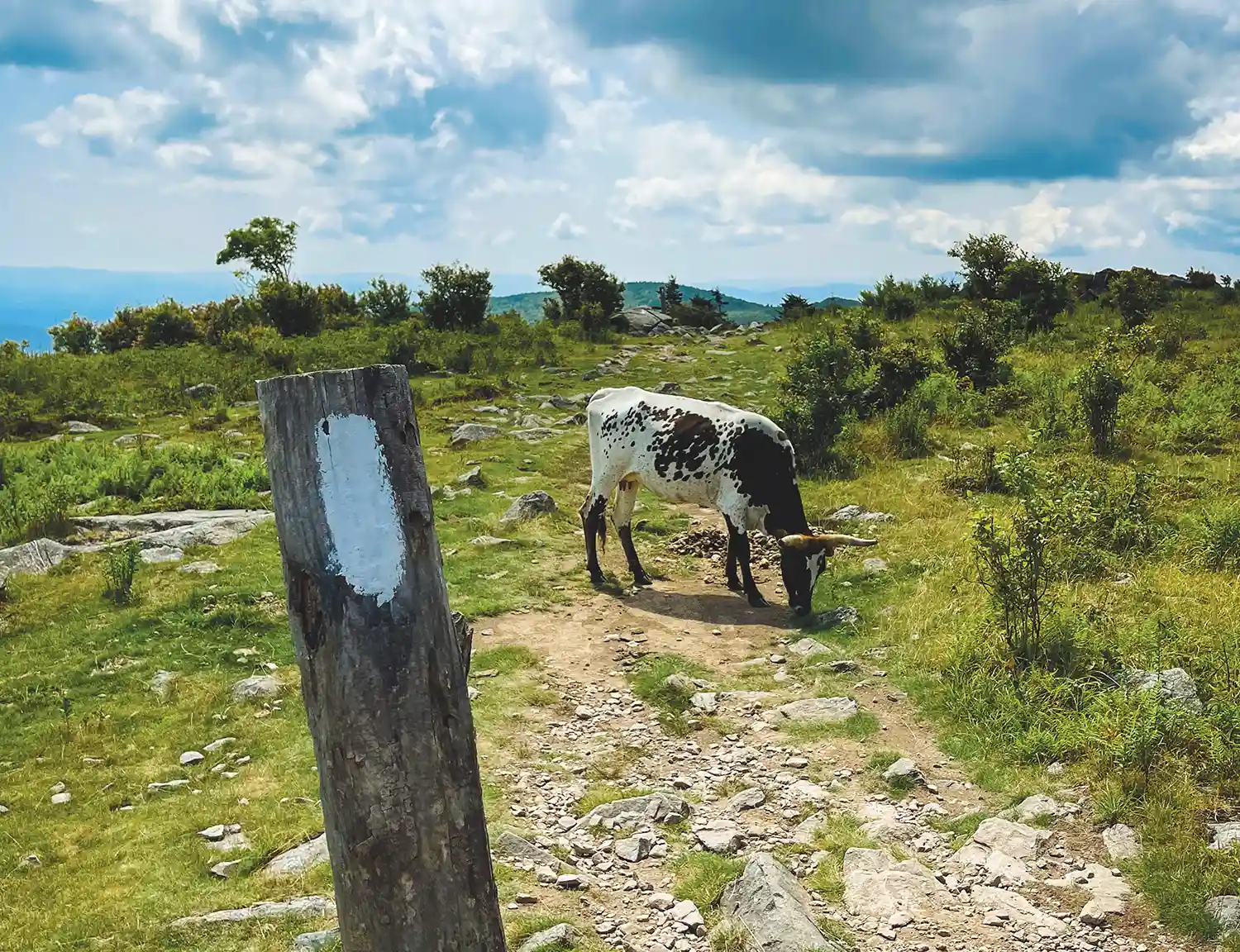
Appalachian Focus
Grayson Highlands State Park in Virginia has much to offer A.T. hikers. Passing longhorns along the Trail is a favorite highlight for many — though hikers are reminded to give the animals space. In addition to the sight of cattle, visitors to the region have the opportunity to experience southern red spruce sky islands, one of the most endangered ecosystems in the U.S.
cynthiaviola.com
The campaign focuses on strategic investments aligned with the ATC’s three core pillars: Protect, Experience, and Belong.
Protect: Ensure a conserved and connected A.T. landscape and manage the Trail’s natural, visual, and cultural resources so people and nature can thrive.
Experience: Cultivate an engaged and expanding community that supports, volunteers, and advocates for the ATC and our mission.
to Protect
the Ridge
The uniqueness of the Ridge demands a few superlatives. It is the most climate-resilient landscape in the state, with a varied topography that includes outcrops, wetlands, and valleys, as well as forested ridgelines. These different habitats are also what make it one of the most biodiverse regions in eastern North America.
“The Kittatinny is so important in the Appalachians for species to be able to have that place to live and survive and to adapt and move as conditions change around them,” explains Marian Orlousky, Director of Science and Stewardship for the Appalachian Trail Conservancy (ATC). The Kittatinny Ridge is part of the Atlantic Flyway and functions as a Global Important Bird Area, making it the most significant bird — and butterfly — migration corridor in the northeastern U.S.
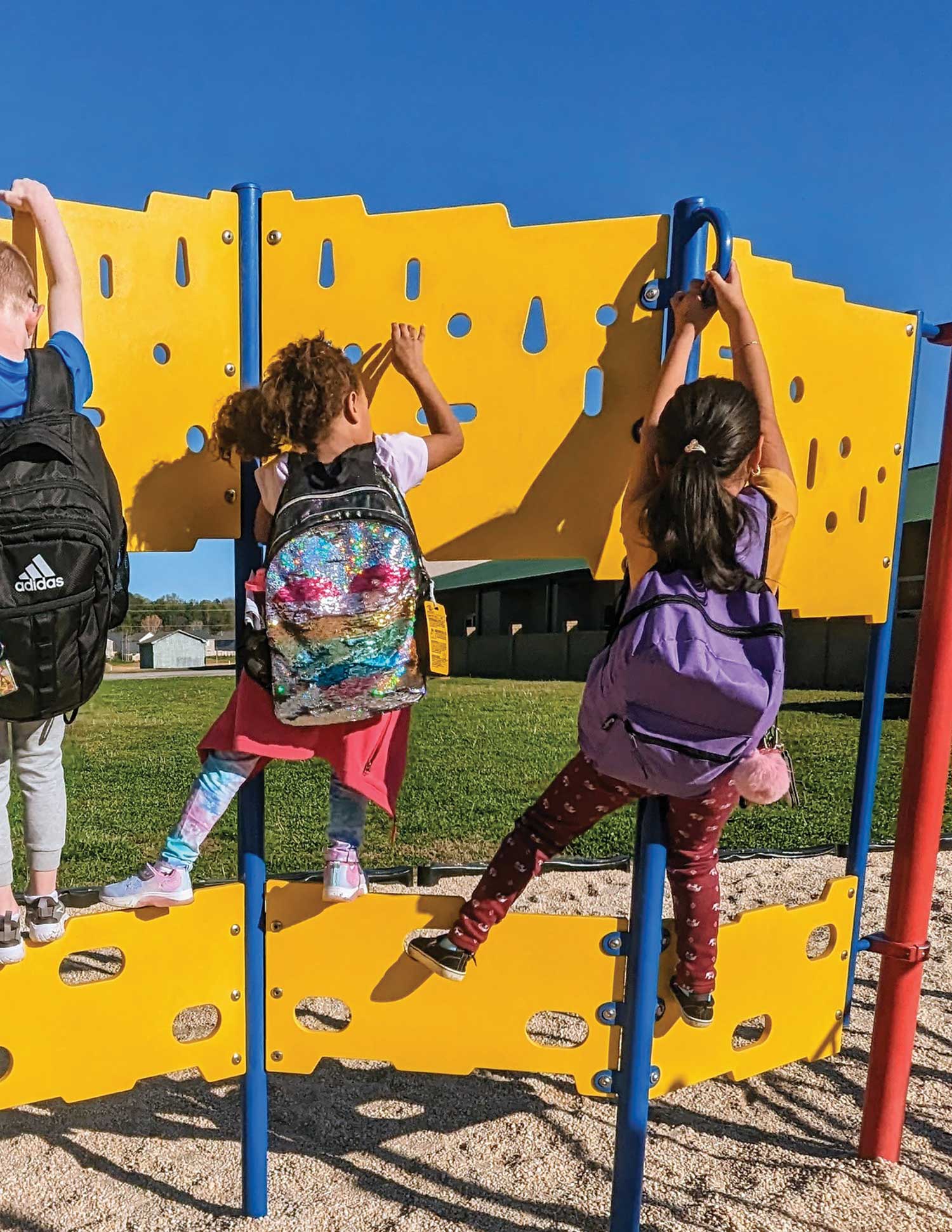
DeHaan calls her program Iris and the Triple Crown Classroom. Throughout the school year, she creatively integrates the A.T., the Continental Divide Trail, the Pacific Crest Trail, and even the Iditarod dogsled race into language arts, math, science, social studies, and more. “A lot of people think that it’s some kind of curriculum that I’m following, but it’s more like a way of life,” she explains. “I weave the trails and trail life into what the school requires me to do.”

After the Trail Days Festival in Damascus in May, enthusiastic volunteers joined the Hardcore crew to work on Trail impacted by Hurricane Helene. Photo by Ben Earp
After the Trail Days Festival in Damascus in May, enthusiastic volunteers joined the Hardcore crew to work on Trail impacted by Hurricane Helene. Photo by Ben Earp


The CMS is often compared to a three-legged stool. In broad terms this means the ATC, its thirty affiliated and independent A.T. Maintaining Clubs, and its agency partners each represent a leg of the stool that supports Trail conservation — working in concert to fund, maintain, and protect the world’s longest footpath. “The three-legged stool is a great analogy, because without one of those three parts it will fall over it. It won’t work,” says Frank White, Mt. Rogers Appalachian Trail Club’s (MRATC) Regional Partnership Council Representative in Virginia. “To me it’s amazing. All of these different entities, from government agencies to youth volunteers, working together for the greater good. It points out the shared vision and the importance of the Trail to people. Without the Cooperative Management System there’s no way the sections of Trail devastated by Helene would be open right now.”
Clubs
LARGELY grassroots
effort of more than
5,000 volunteers
across 30 trail clubs.
Thank you to the Appalachian Trail Clubs!
find your volunteer opportunity at appalachiantrail.org/waystovolunteer


to the thousands of generous members, donors, volunteers, partners and supporters who made the work of the Appalachian Trail Conservancy possible in 2024. Because of your ongoing investment in our mission, we were able to protect, manage, and advocate for the A.T. in 2024, and continue to work tirelessly on behalf of the Trail in 2025. Millions of visitors enjoy the A.T. every year, and you are part of making that possible.
We hope these pages have demonstrated that impact in every issue. In this report, you’ll find more information about our 2024 financials as well as a listing of our most generous supporters. You can view our full audited financial statements on our website at appalachiantrail.org/transparency.
One of the most important gifts our members and supporters bestow upon us is their trust in managing the funds they donate. We take this responsibility very seriously and hold ourselves to the highest standards of financial accountability and transparency.


voices from the trail
Moving, taking one step after another was cathartic — something that I could do when I could not do much of anything else. Trailheads and peaks were destinations that I could reach while still in a sort of zombie mode. It was a positive way for me to feel a little more productive, a little more human. This remedy for my “big empties” was to go bigger and emptier: my smallness in wilderness was strangely comforting. The sun came up and the sun went down, regardless of how I felt about it or how I felt about myself. The world kept turning. The Trail stretched ahead of me. I couldn’t mess that up.
So, I pushed on. One foot in front of the other. More miles, more peaks, more victories. I became highly motivated, absolutely convinced that if I were the best version of me, I could “cure” myself the way antibiotics clear an infection. I truly believed that my struggles with mental health were only situational, despite being recurrent for years. Rather than accepting a depression diagnosis as truth, I rejected it as a label of inadequacy. I believed if I reached some When, I would be healed. I would be secure When I found a new job. I would be content When I finished 100 miles. I would be happy When the pandemic ended. It was easier for me to rationalize away my struggles during this global crisis. Of course I was depressed! Weren’t we all a bit depressed?
From one day to the next, this cooperative spirit plays out remarkably well through a combination of actions to ensure that the A.T. is protected and managed to a high standard. Every once in a while, this synergy is raised and tested at a heightened level, and several years ago I had the benefit of participating in a few technically complex shelter projects on the A.T. that brought together the right people, at the right time, in the right place. We were replacing the shelter at Kinsman Pond in the White Mountains with a log structure (Full Scribed Swedish Coped design) that was initially pre-built off-site, disassembled, transported to a staging area, then airlifted by helicopter to the shelter site.
The project required full engagement of all partners in the CMS planning, communicating, and working in stride. The White Mountain National Forest as land manager provided engineering review and design approval, permits, and the necessary compliance processes with the National Environment Policy Act (NEPA). The NPS Appalachian National Scenic Trail office (APPA) provided public funding, the local trail club provided skilled labor, and the ATC provided technical expertise and additional private funding through generous donations. The project also involved two outside contractors: the highly skilled, highly regarded principal from the Wooden House Company from Wells River, Vermont, and one of the top pilots from JBI Helicopters based in Pembroke, New Hampshire.
